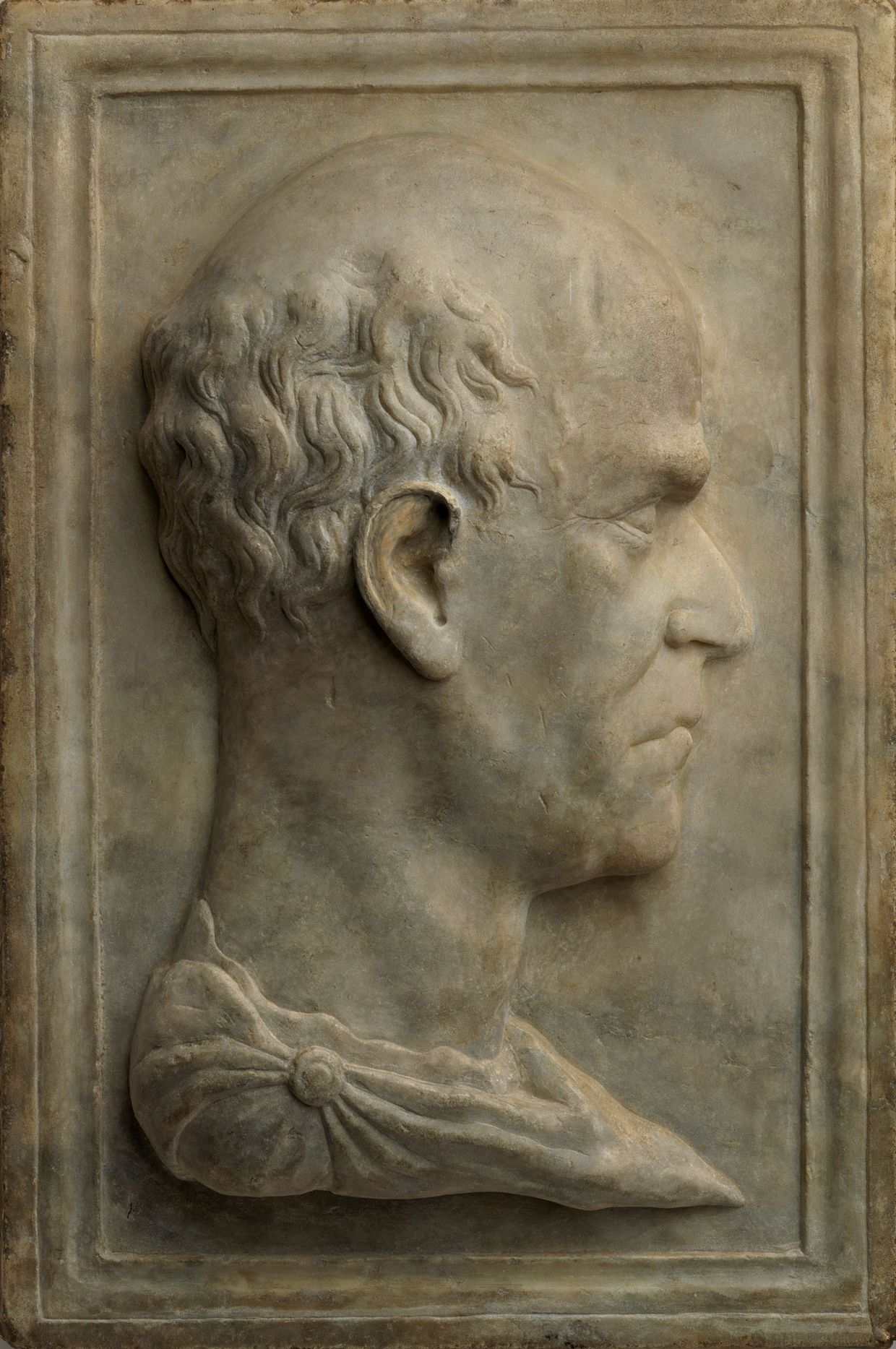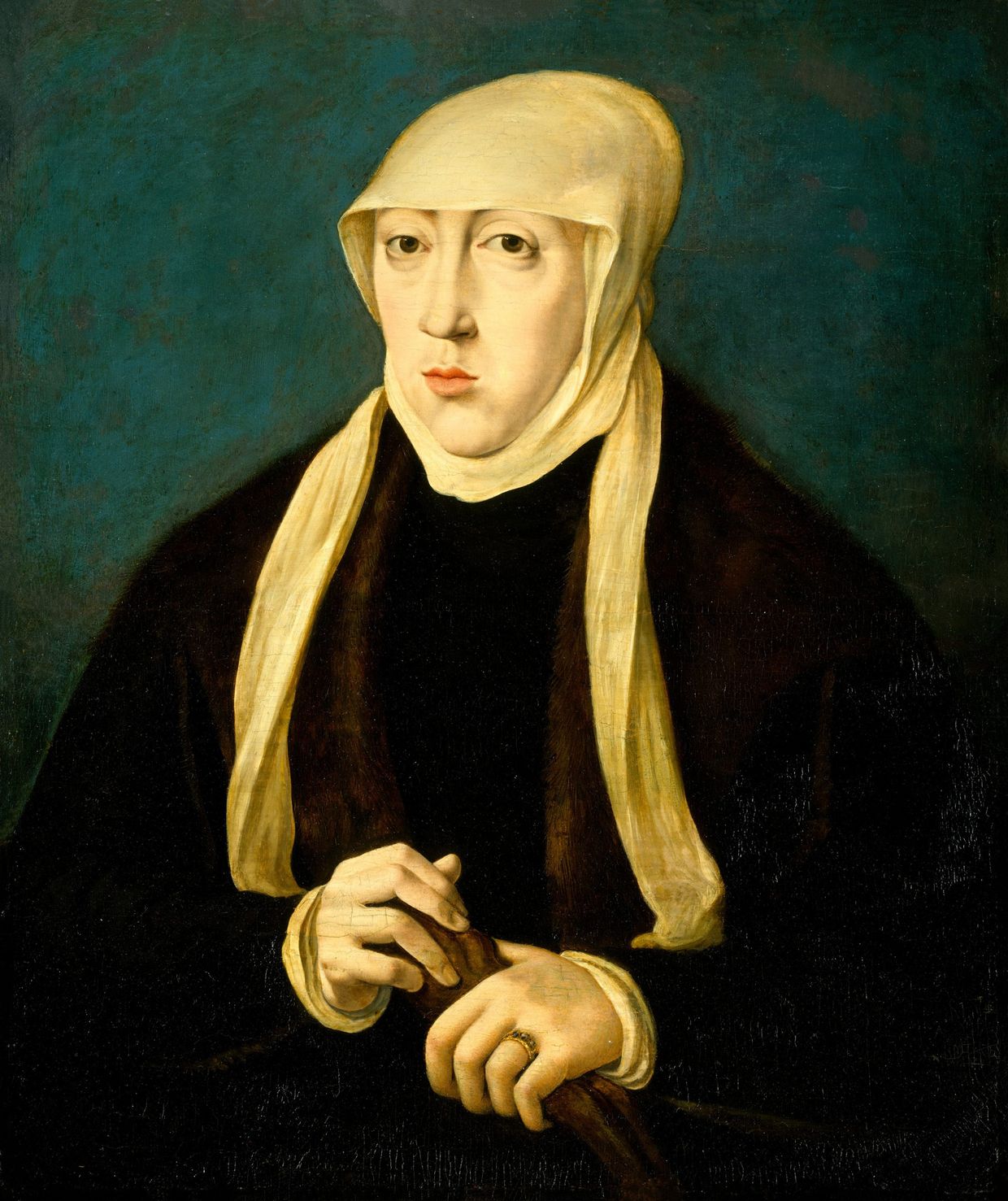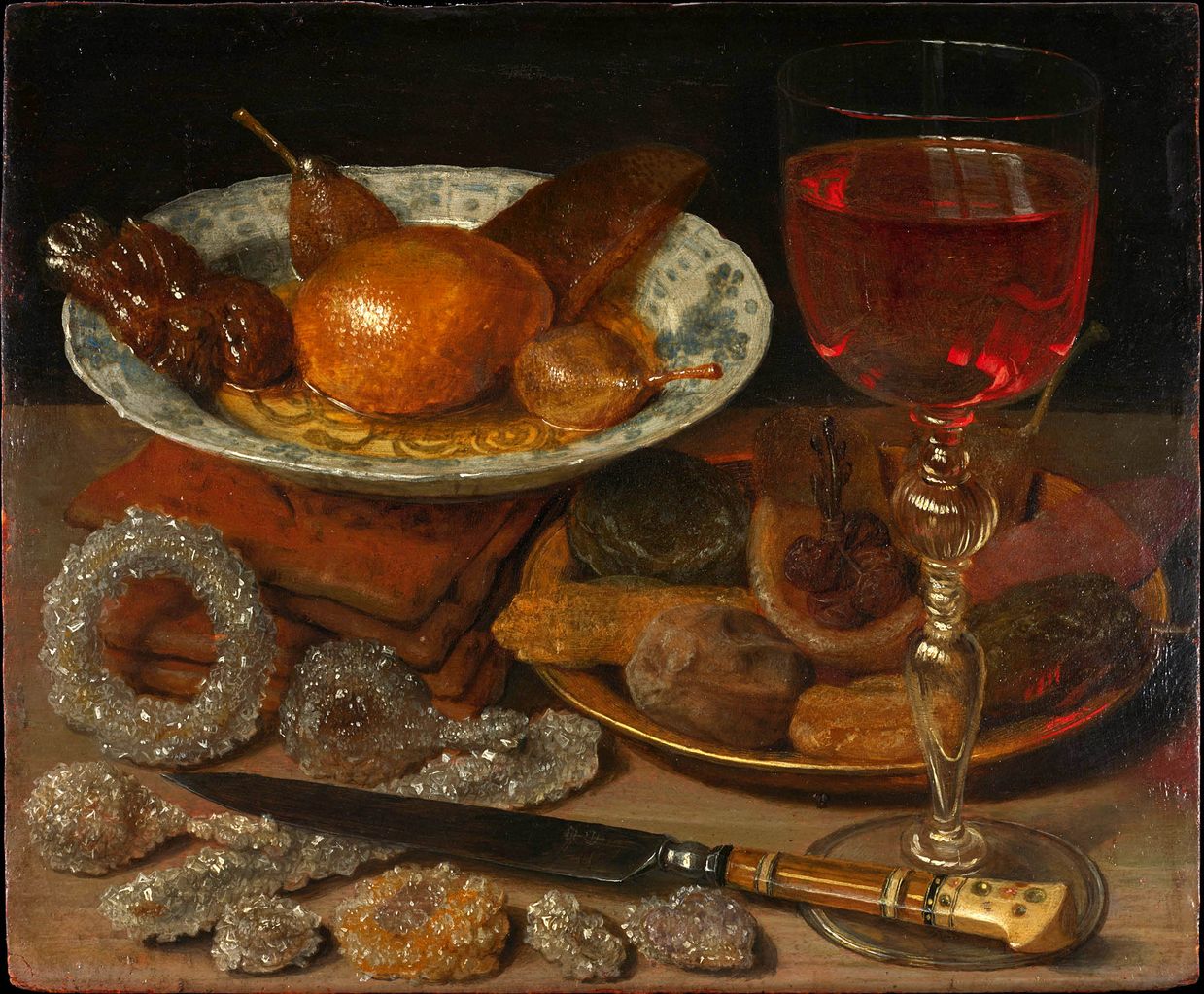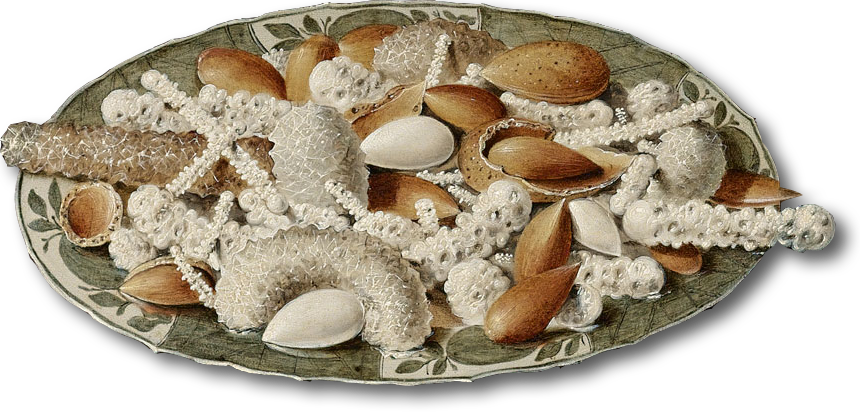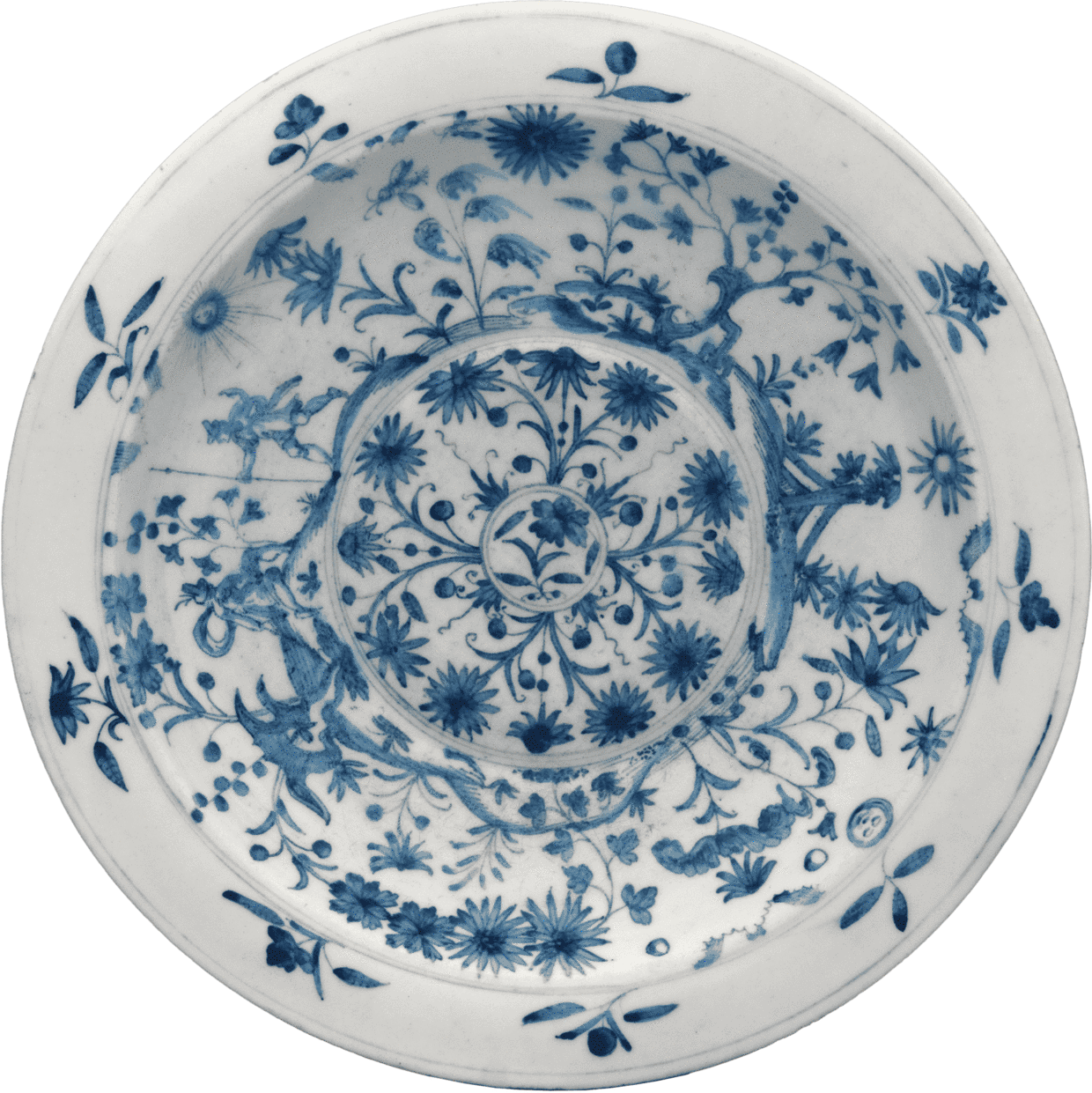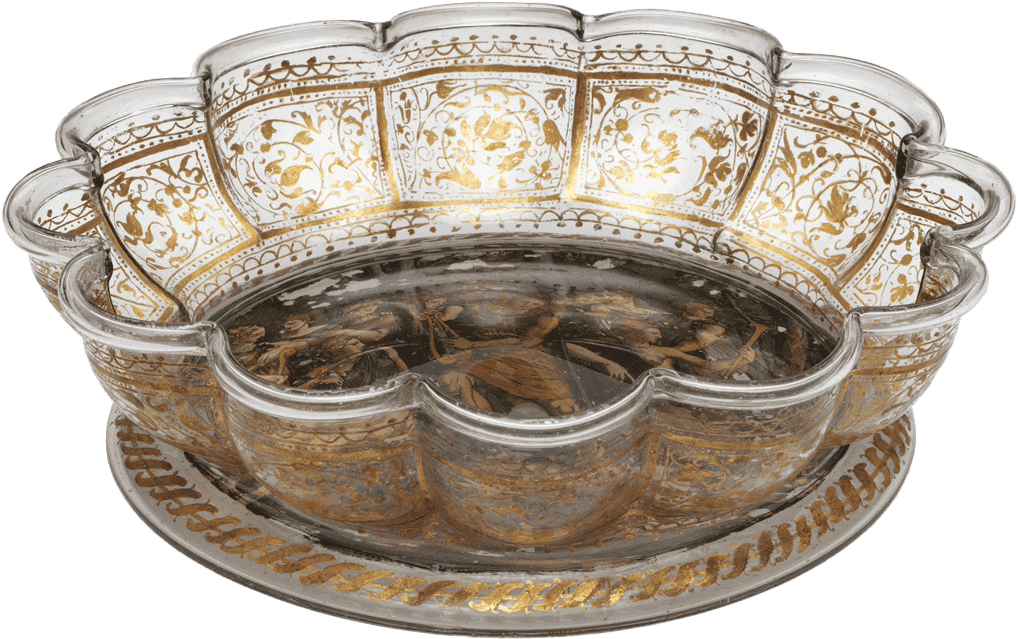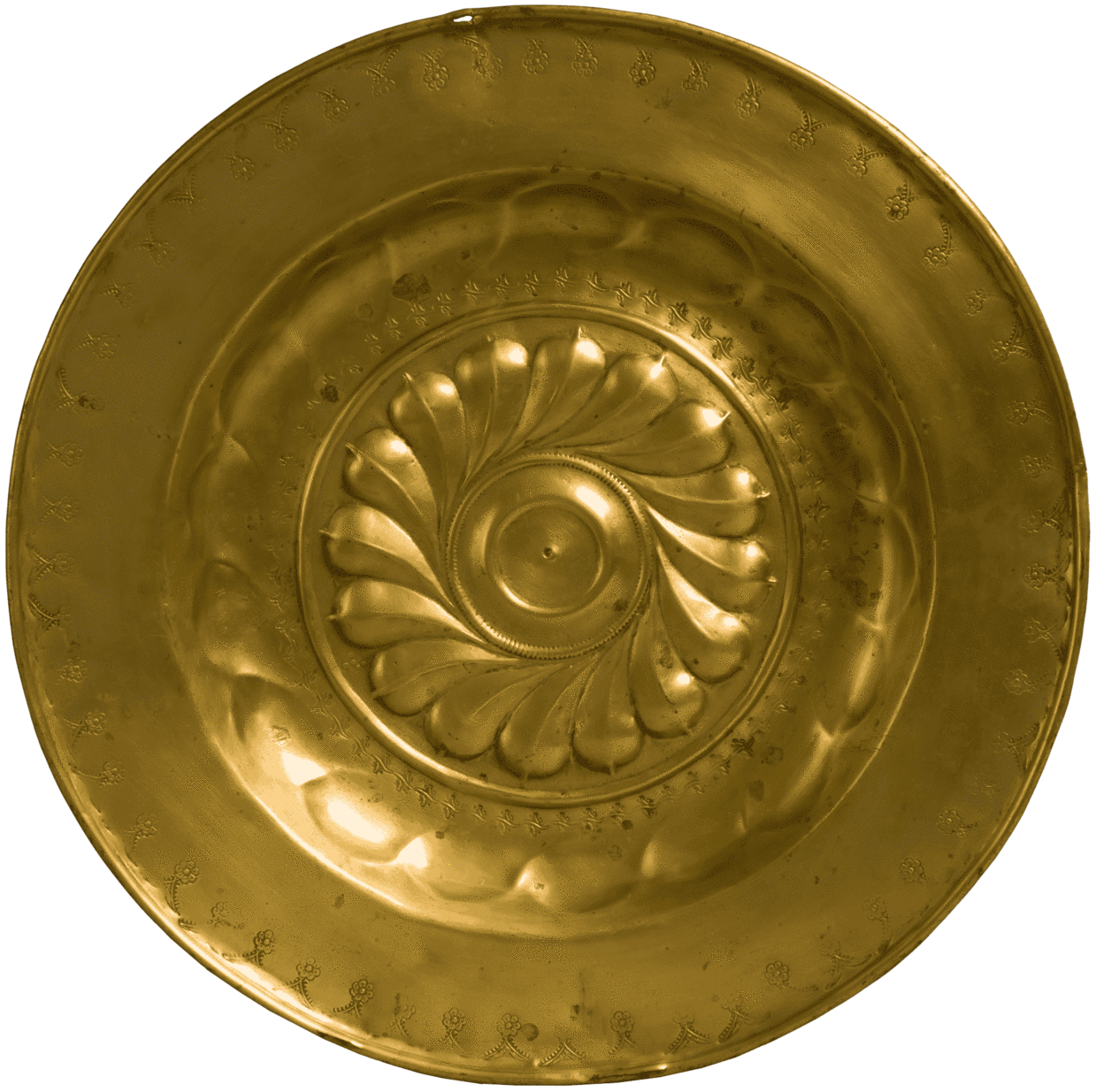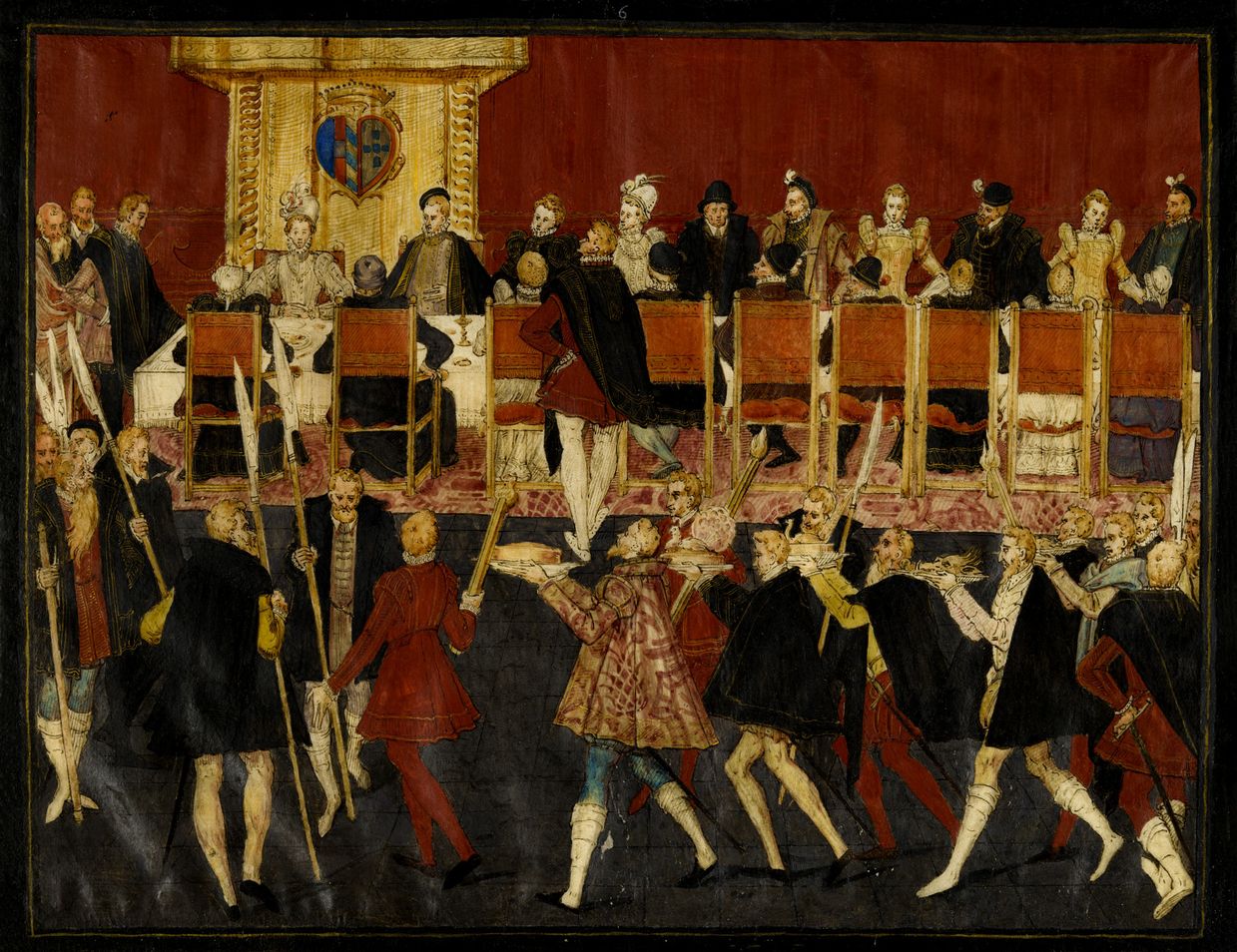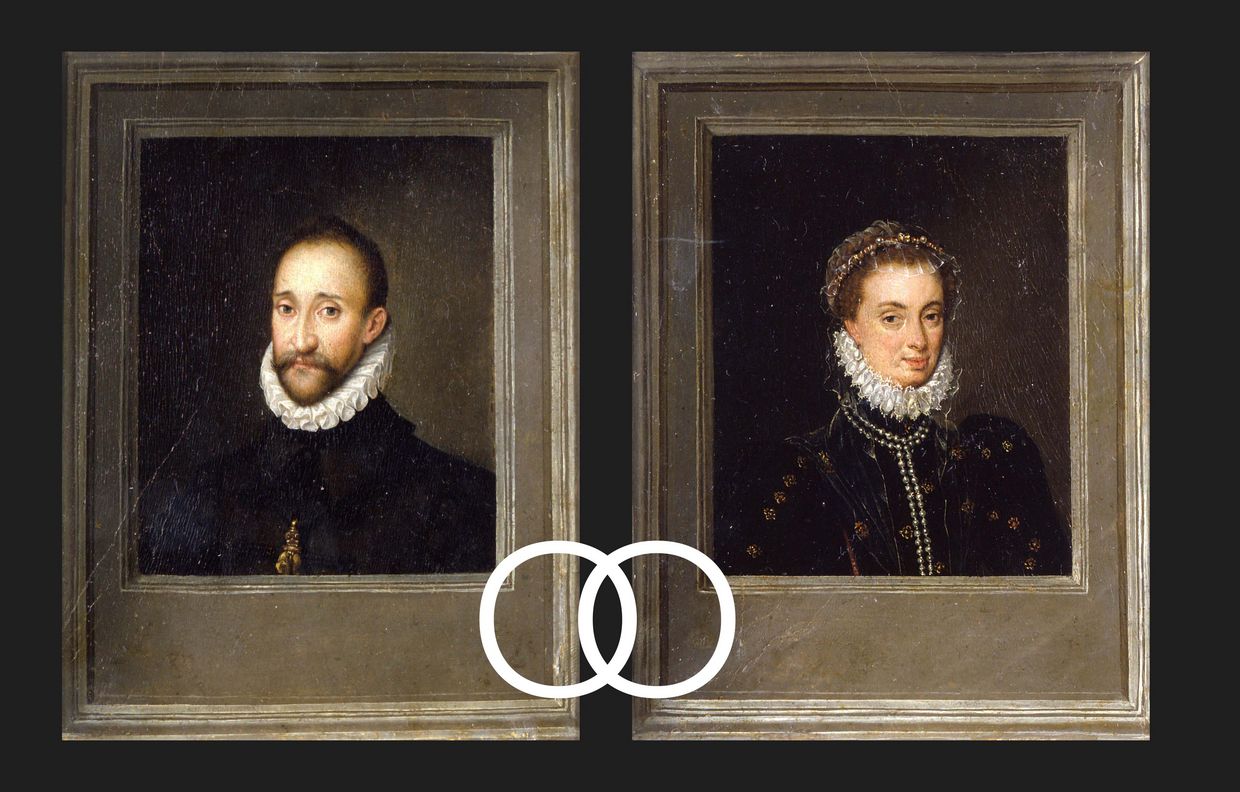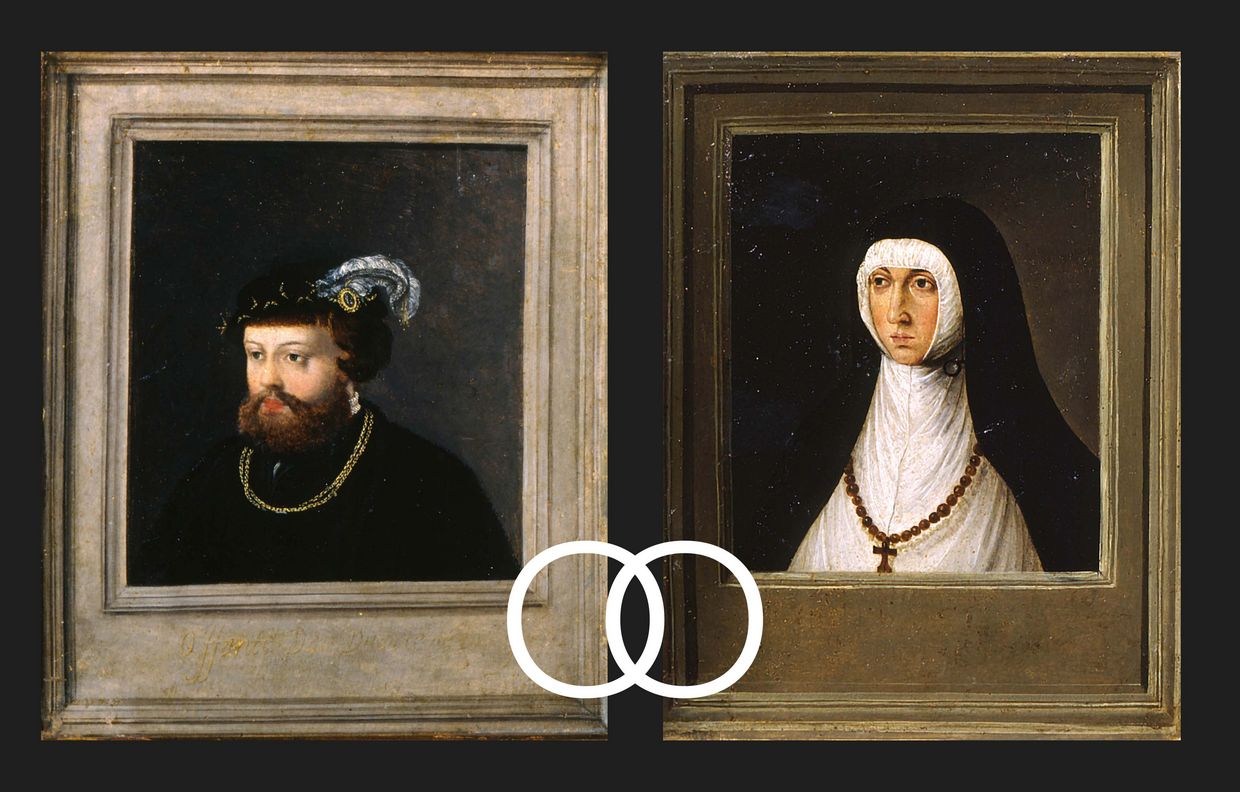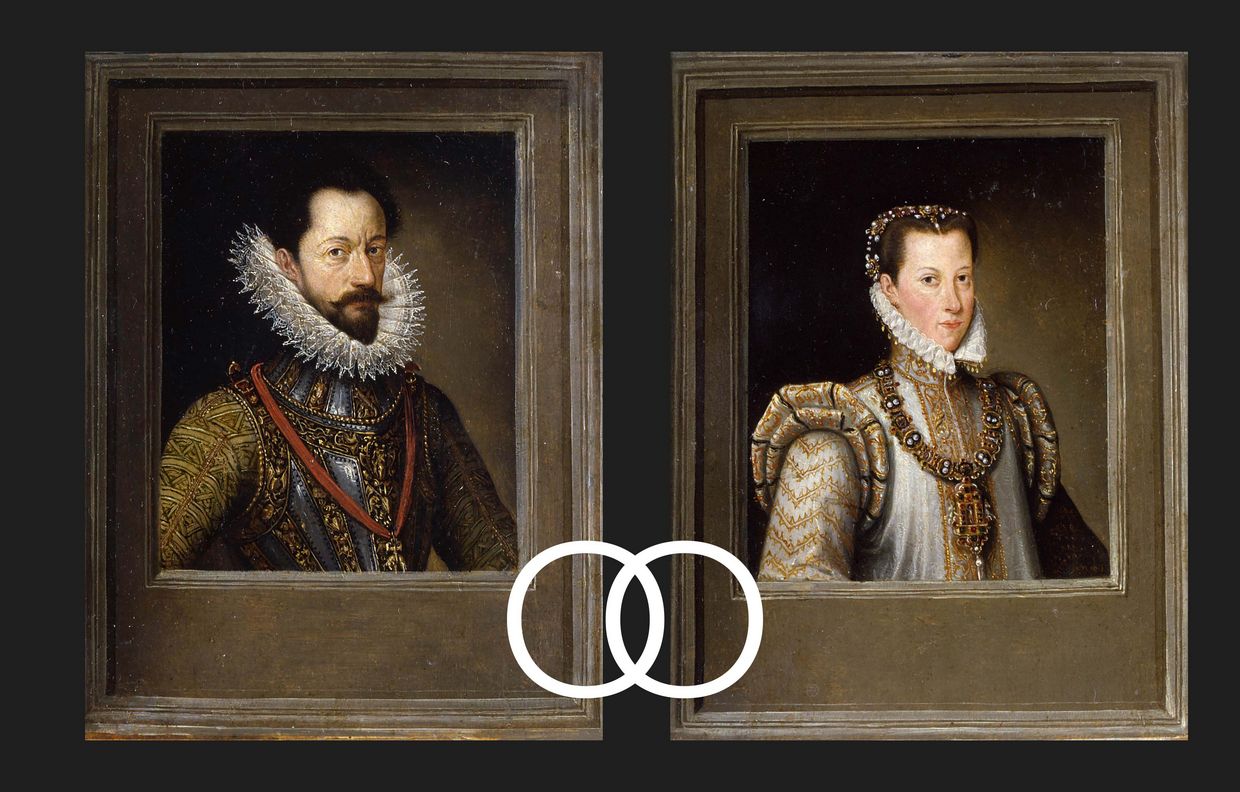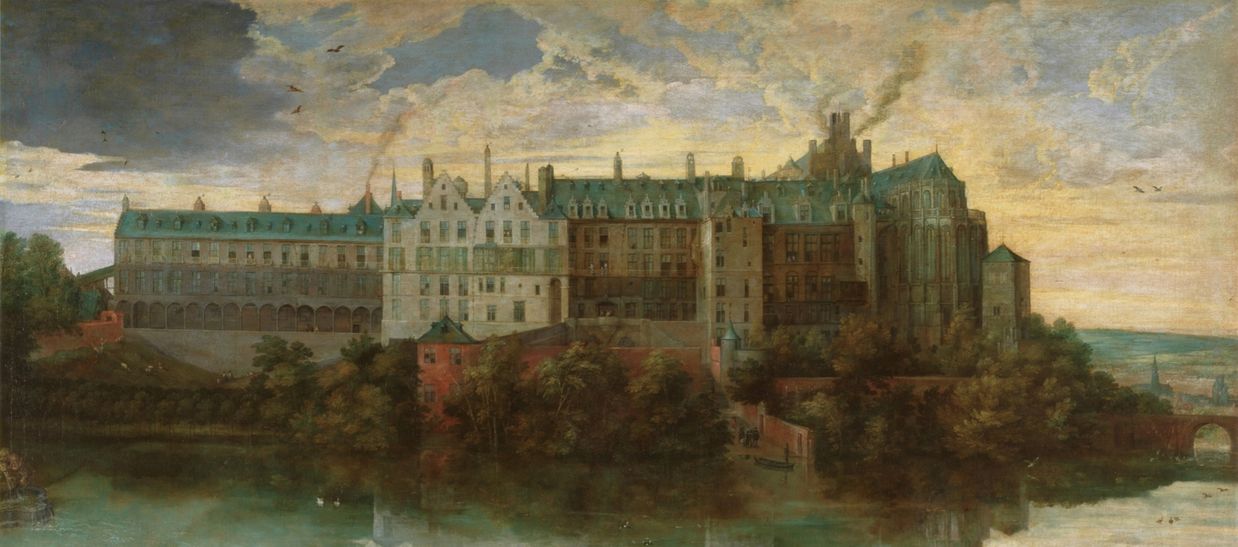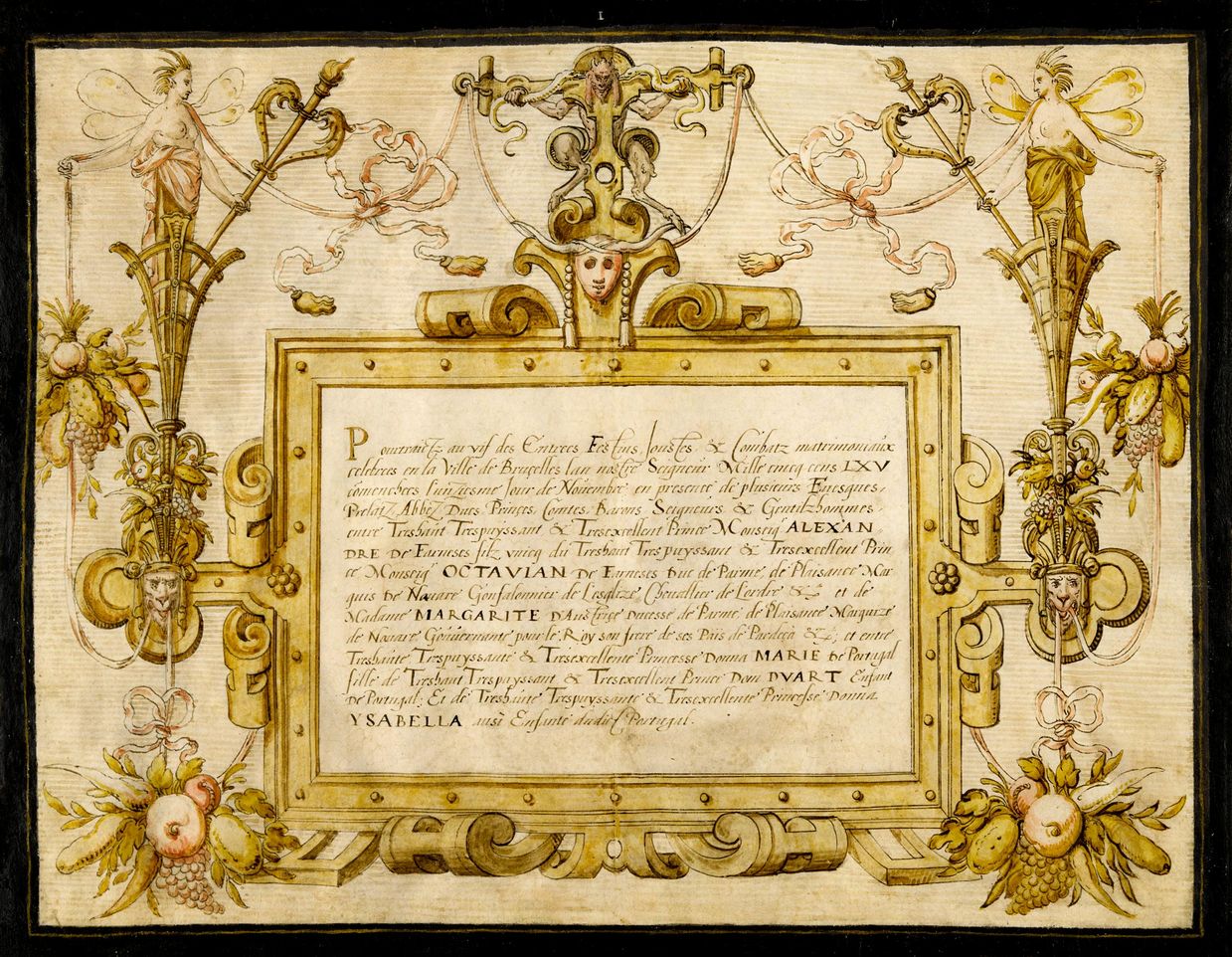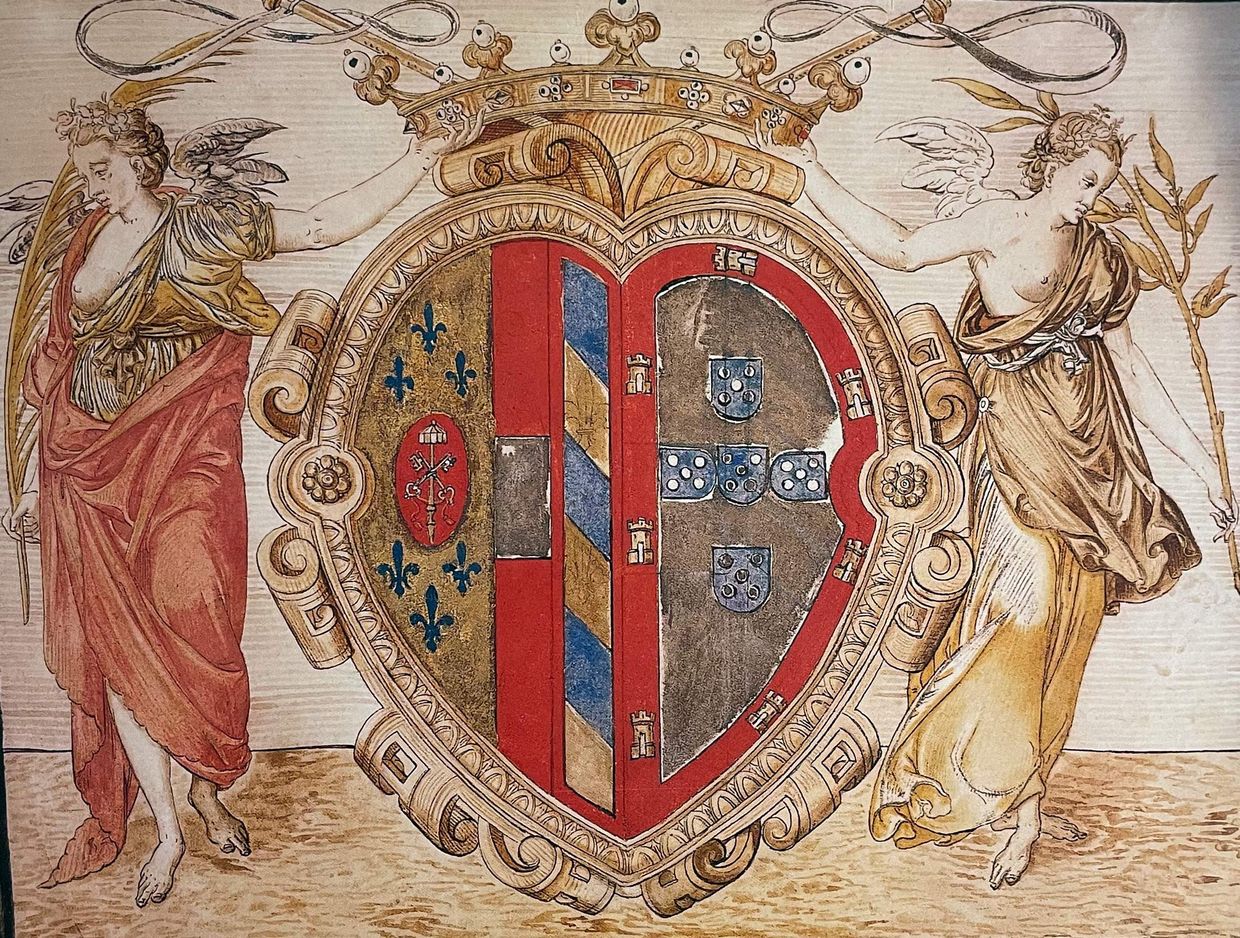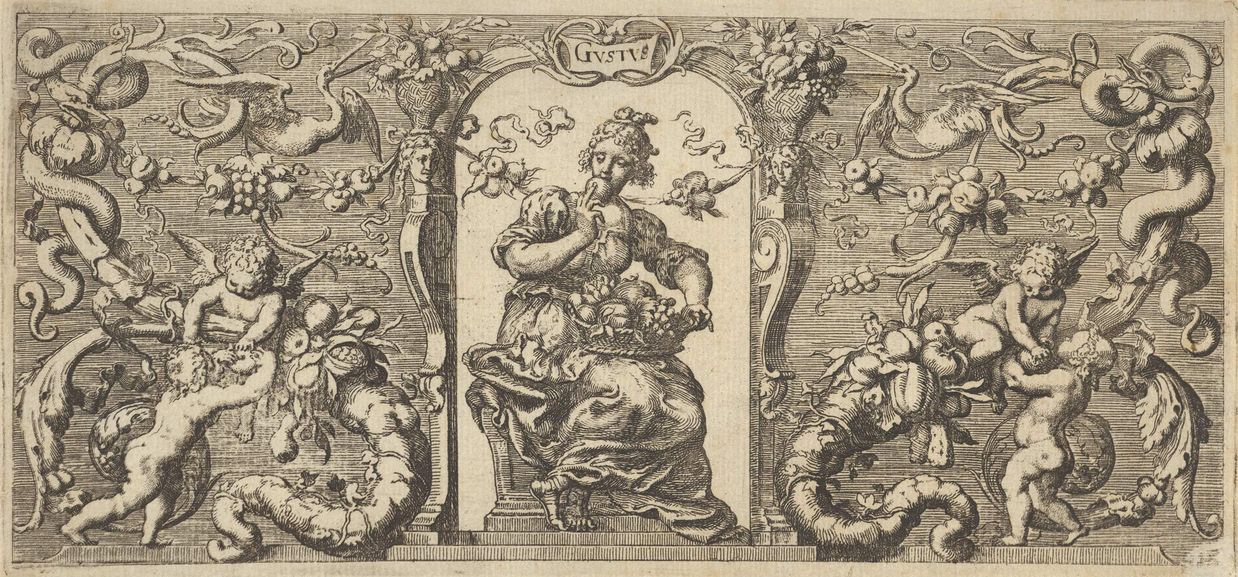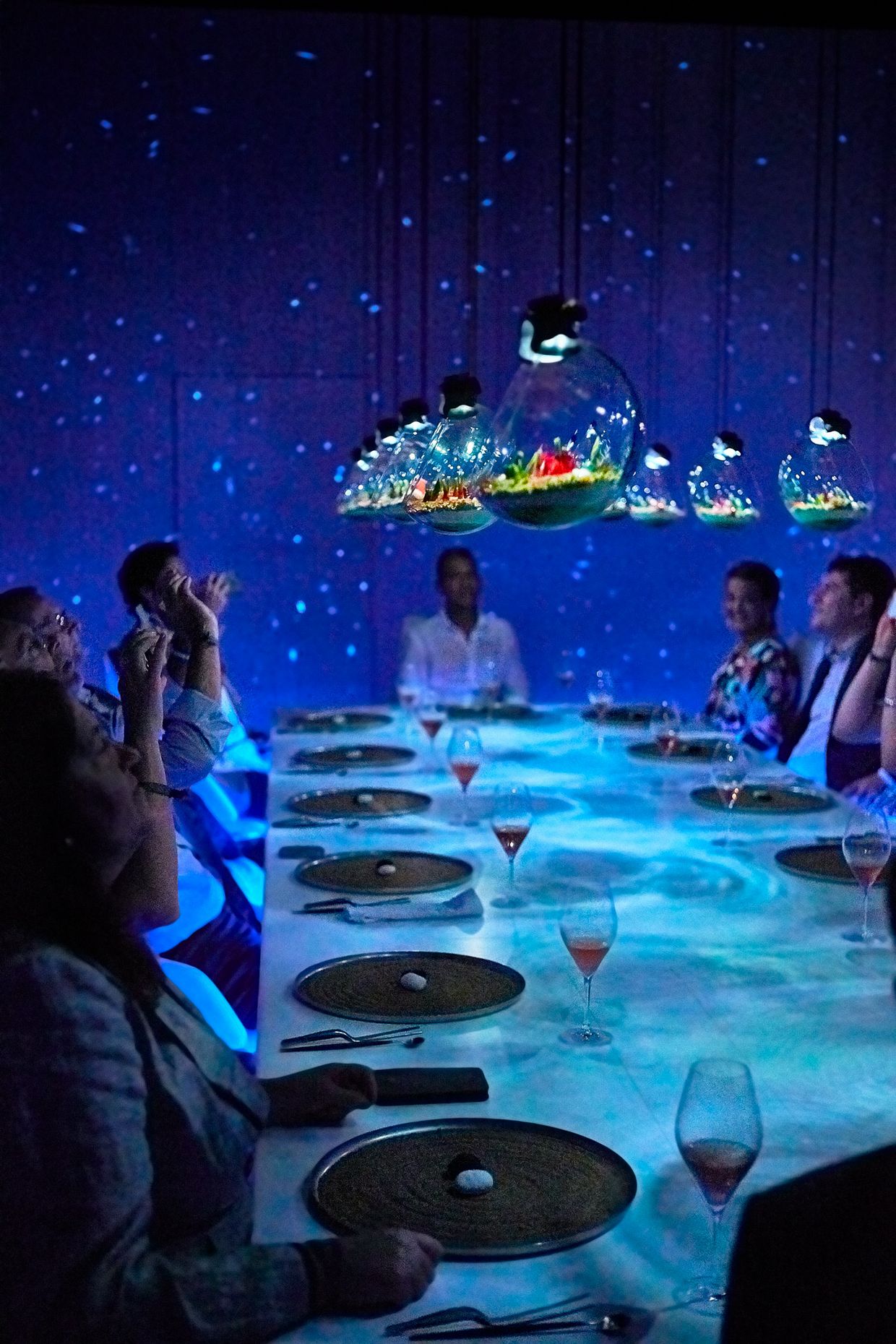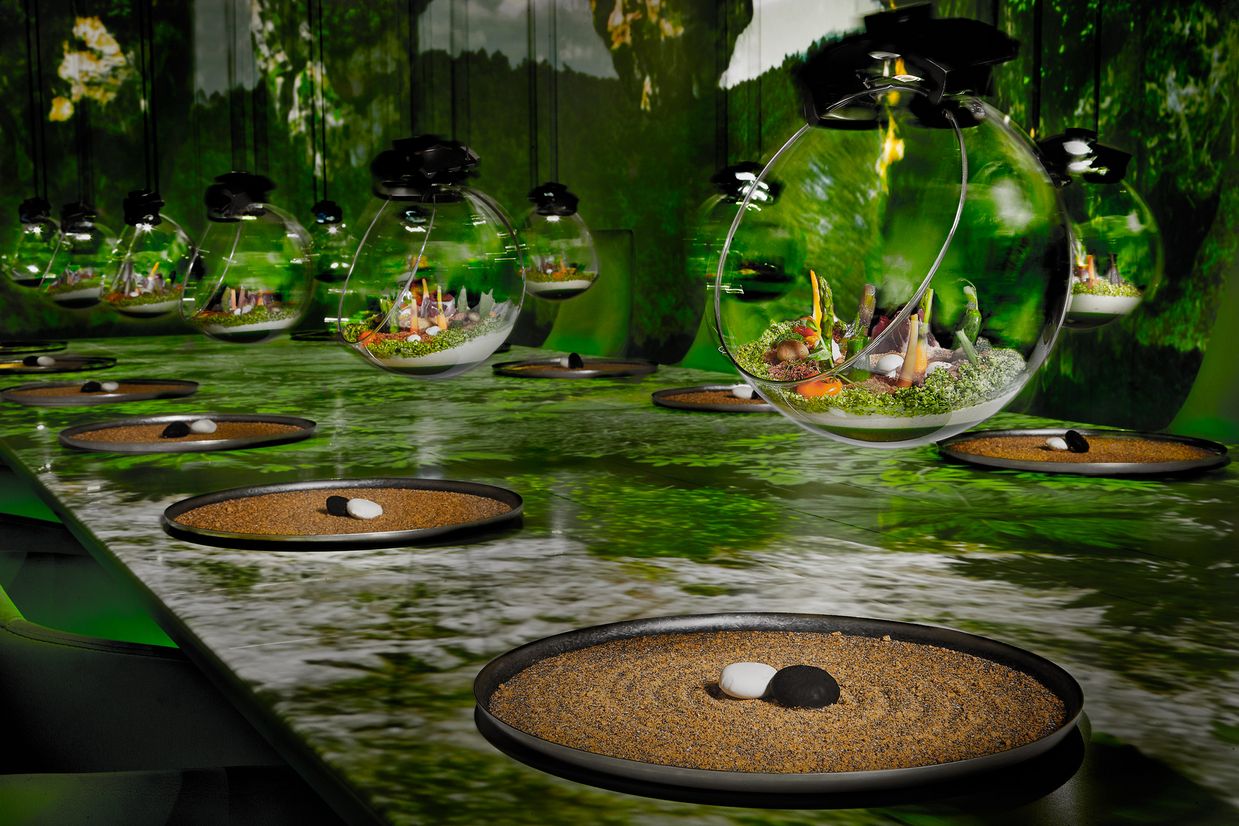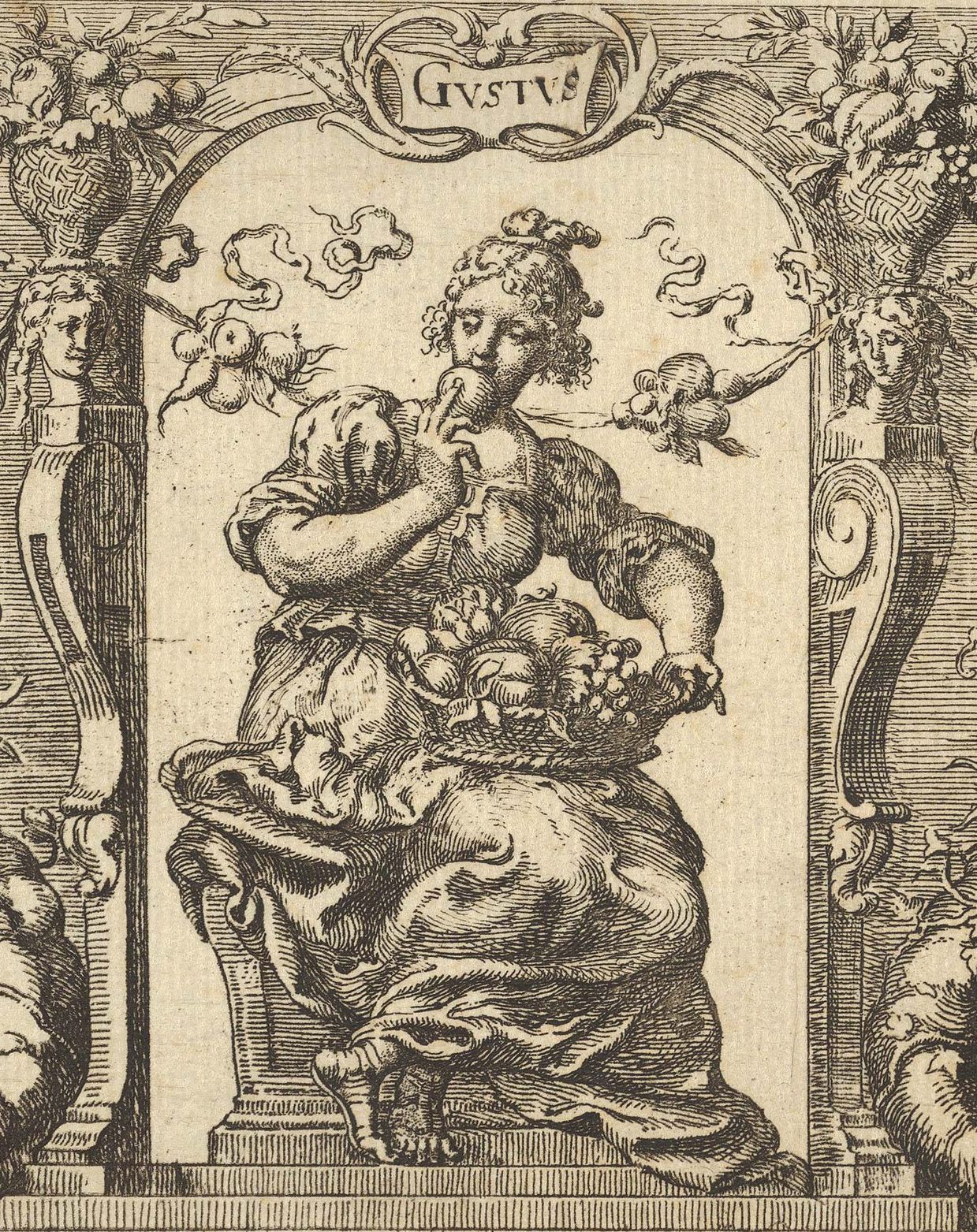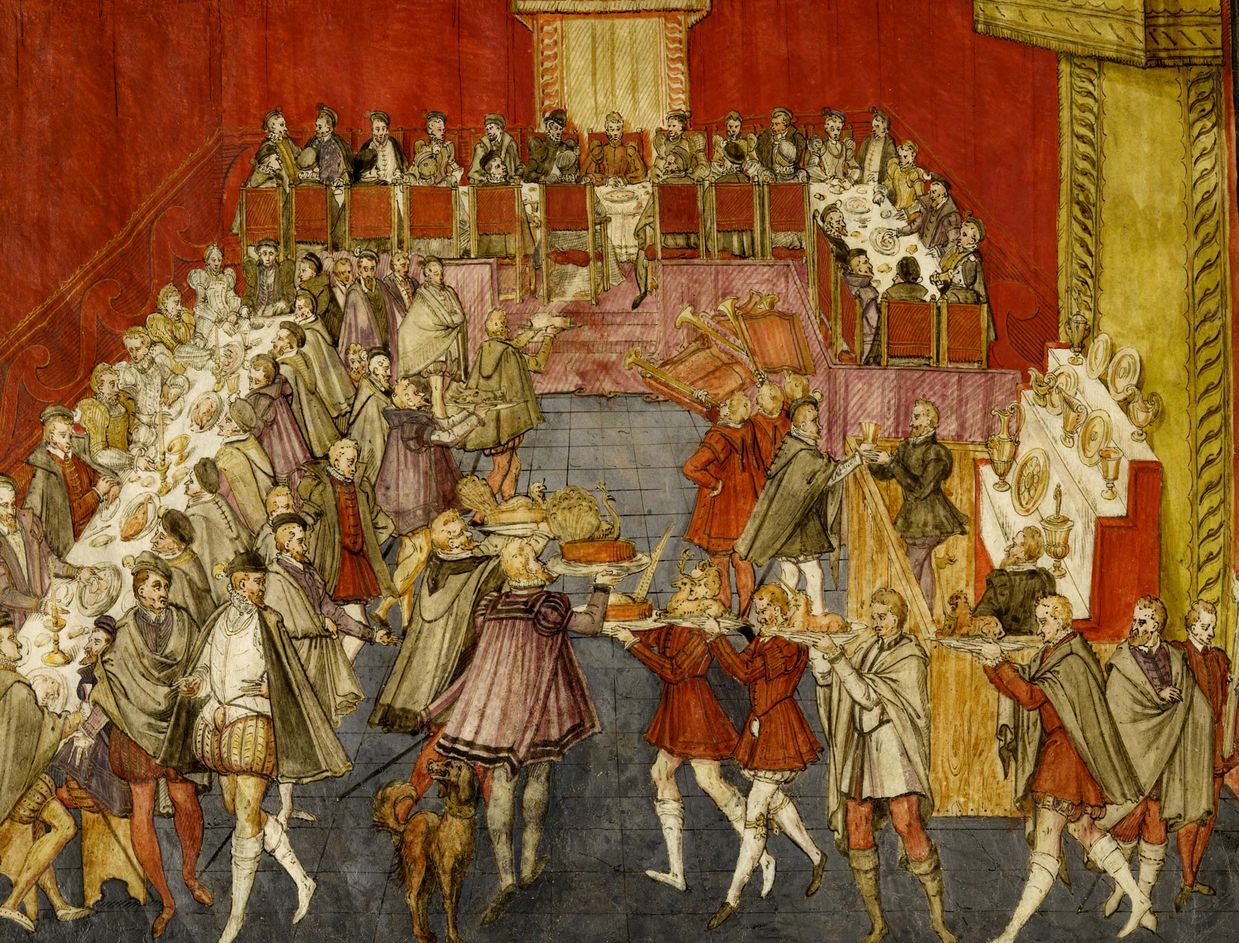Taste
The flavour of magnificence
Carmen Abad Zardoya • Pedro Flor • Daniel Ortiz Pradas
Anonymous, The ‘Enchanted Chamber' of the Castle of Binche, 1549. Brussels, KBR, Inv. F 12931.
In the early modern era, the sense of taste, inseparable from the senses of smell and touch, gained prominence, particularly at courtly feasts.
These feasts were a form of gastronomical theater in which the experience of taste was developed within an immersive and multimedia environment.
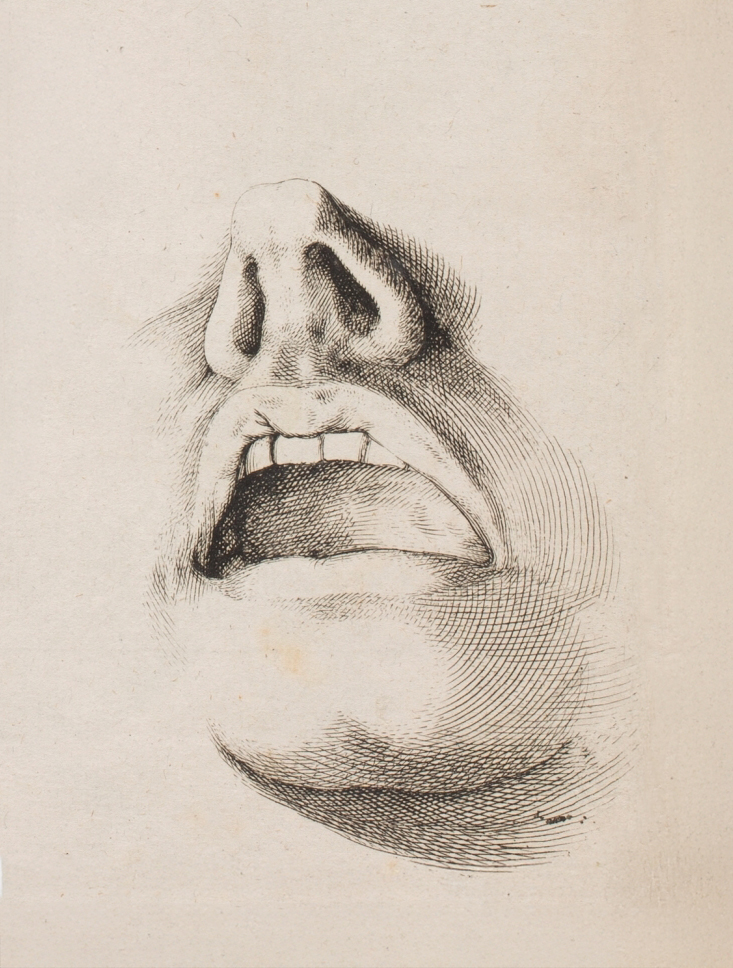
Anonymous after José de Ribera, Nose and Mouth Study. Madrid, Museo del Prado, Inv. G002545/004. © Archivo Fotográfico del Museo Nacional del Prado.
Do you know how things were tasted at early modern court festivals
?
Adriano Fiorentino, Portrait of Giovanni Giovano Pontano, ca. 1490. New York, Metropolitan Museum of Art, Inv. 1991.21.
In his writings about social virtues, the humanist Giovanni Pontano identified four different types of feasts as programmed occurrences. These events involving the third and fourth senses were meant to exhibit a prince’s virtues and were celebrated among his equals.
A formal banquet as part of a special occasion was the most direct way of allowing a host court’s splendor to shine, while an early modern “collatione” showed a more subtle sense of refined magnificence. Visual narratives were developed by way of ornaments made of sugar which were not only attractive to the eye but also to the palate.
We invite you to enjoy a tasting at a collation…
or maybe you would rather enjoy a banquet?
In any case, you can enjoy both experiences from a scenographic viewpoint!
Collations: The refinement of magnificence
You’ve chosen the collation of Binche, described in Prince Don Felipe’s Felicissimo viaje, written by Cristóbal Calvete de Estrella.
In the 16th century, a ‘collatione’ (collation) was a variant of the banquet almost entirely composed of sweets made of refined sugar which guests took straight from the table whenever they pleased.
We are at Binche Castle, the residence of Mary of Hungary, Charles V’s sister.
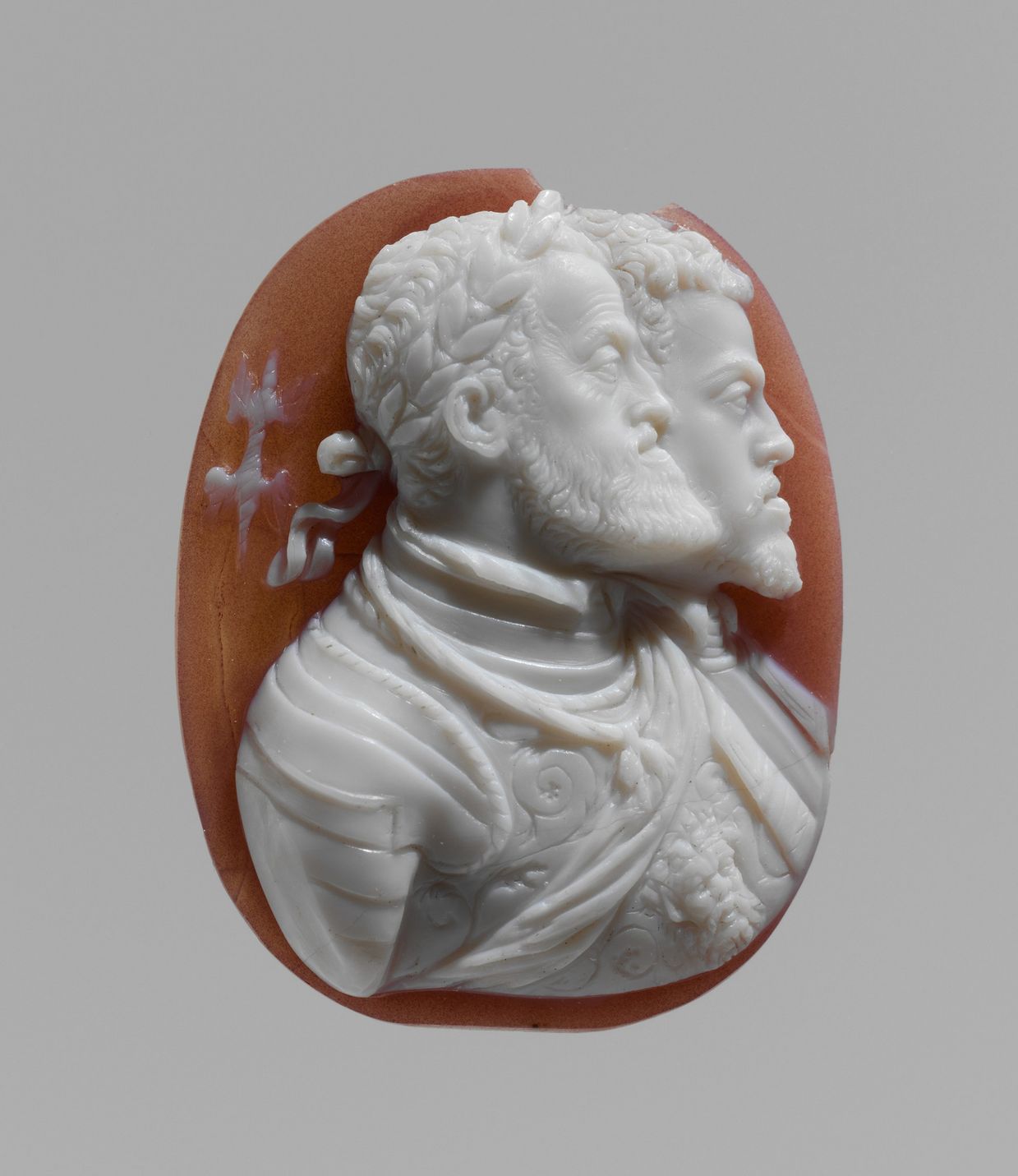
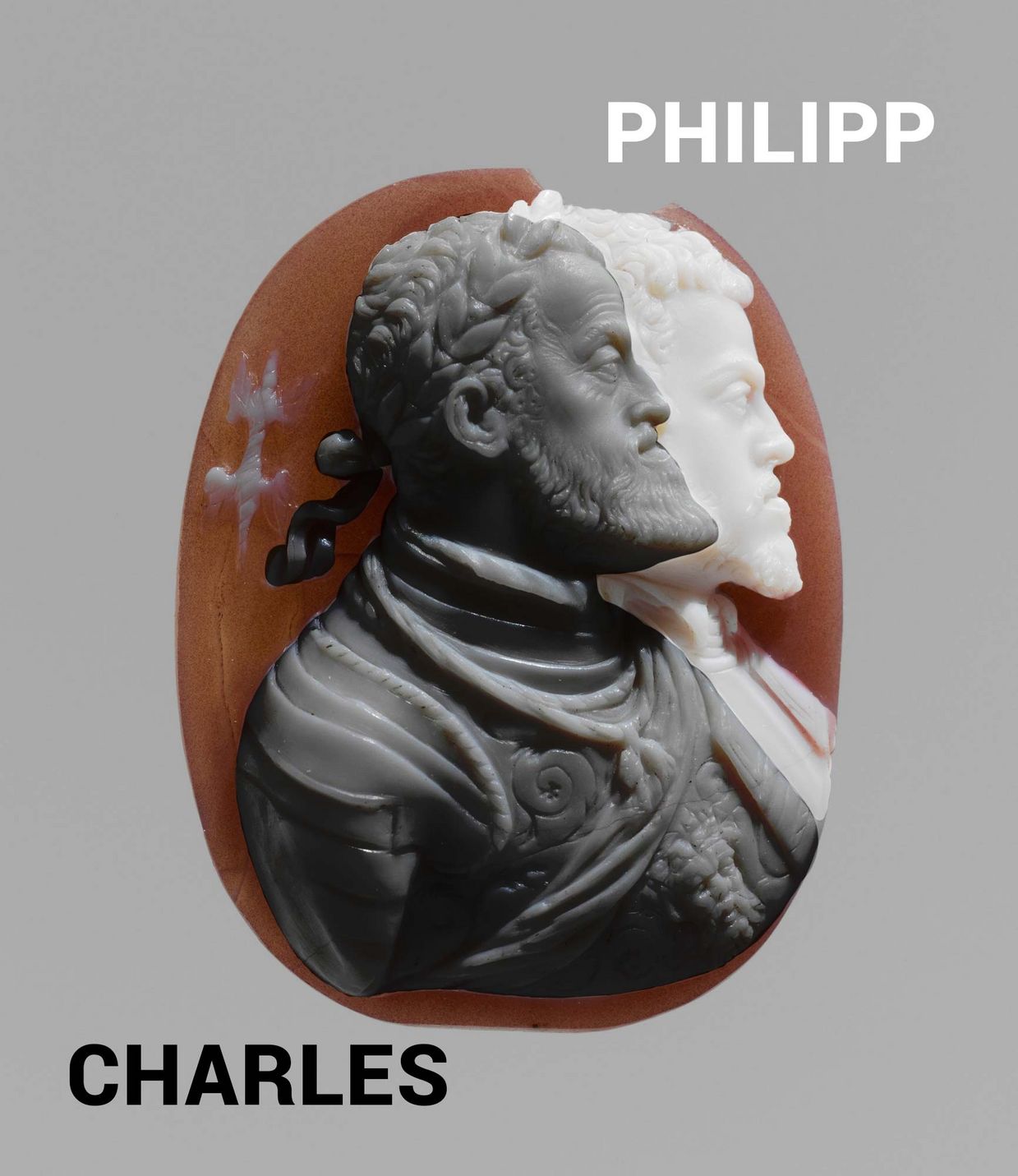
Leone Leoni, The Emperor Charles V and his Son Philip II, 1550. New York, Metropolitan Museum of Art, Inv. 38.150.9.
In August 1549, the widowed queen offered a party planned to the very last detail in order to exalt the figure of the Emperor as well as that of his son Phillip. Phillip was presented as the successor, ready to take the reigns of the empire.
The legendary parties of Binche culminated, after eight days of tournaments and other amusements, with a magnificent nocturnal collation. After supper, the guests danced in the “Real sala de las medallas” (Royal hall of medals) situated on the castle’s noble floor.
Near midnight, the hostess conducted her nephew Felipe and his siblings, as well as the emperor and the queen of France, into a room on the lower floor which was given the name of “Cámara Encantada” (Enchanted Chamber).
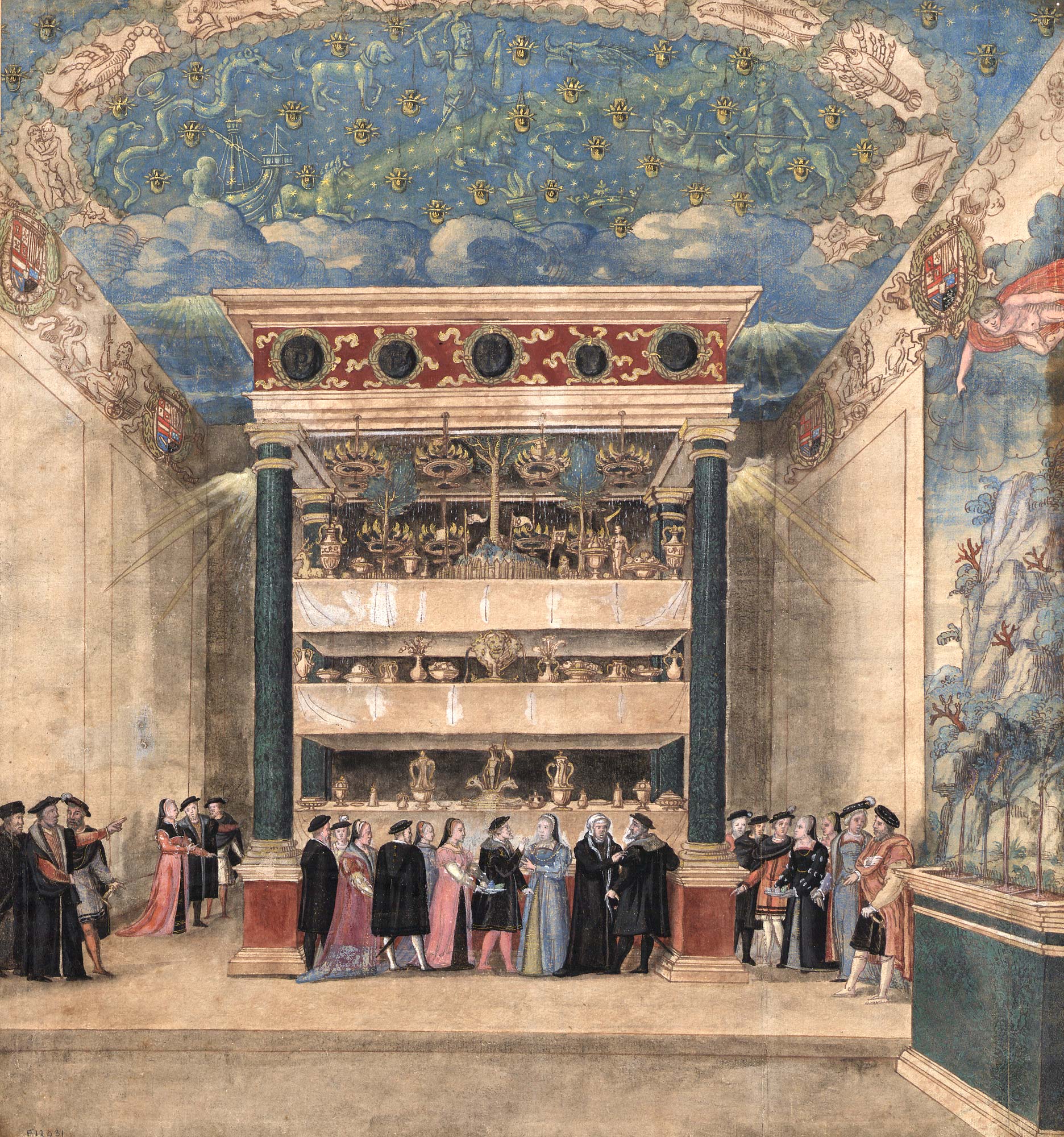
The ceiling of the chamber was divided into two zones, one painted with clouds the other with stars. Under the astral symbols of the painted decoration, hung lamps perfumed or mixed with camphor oil. The theatrical effect caused by the movement of the flames mirroring the twinkling of the stars is specified in Il Secondo Libro di Prospettiva di Sebastiano Serlio.
Underneath the zone ornamented with clouds an impressive architectonic structure was installed, which rested upon four big columns of the Tuscan order. In the enchanted chamber only the subtle sound of the fountain installed on one of the walls could be heard.
Suddenly, the gentle murmur of the fountain was replaced by the roar of a storm. The sky thundered and a rain perfumed by roses, orange blossom, musk and civet oil poured down upon those present. Directly following, hail composed of small anise, fennel or coriander seeds coated in white sugar fell upon the guests.
From the top of the huge structure, lightning emanated, probably created by operators hidden in the frieze of the architectonic construction.
Meanwhile as the guests were distracted by the fictitious storm, a table full of delicacies descended from the sky and came within their reach.
The extraordinary descent was made possible by a system of pulleys and ropes hidden within the four large Tuscan columns.
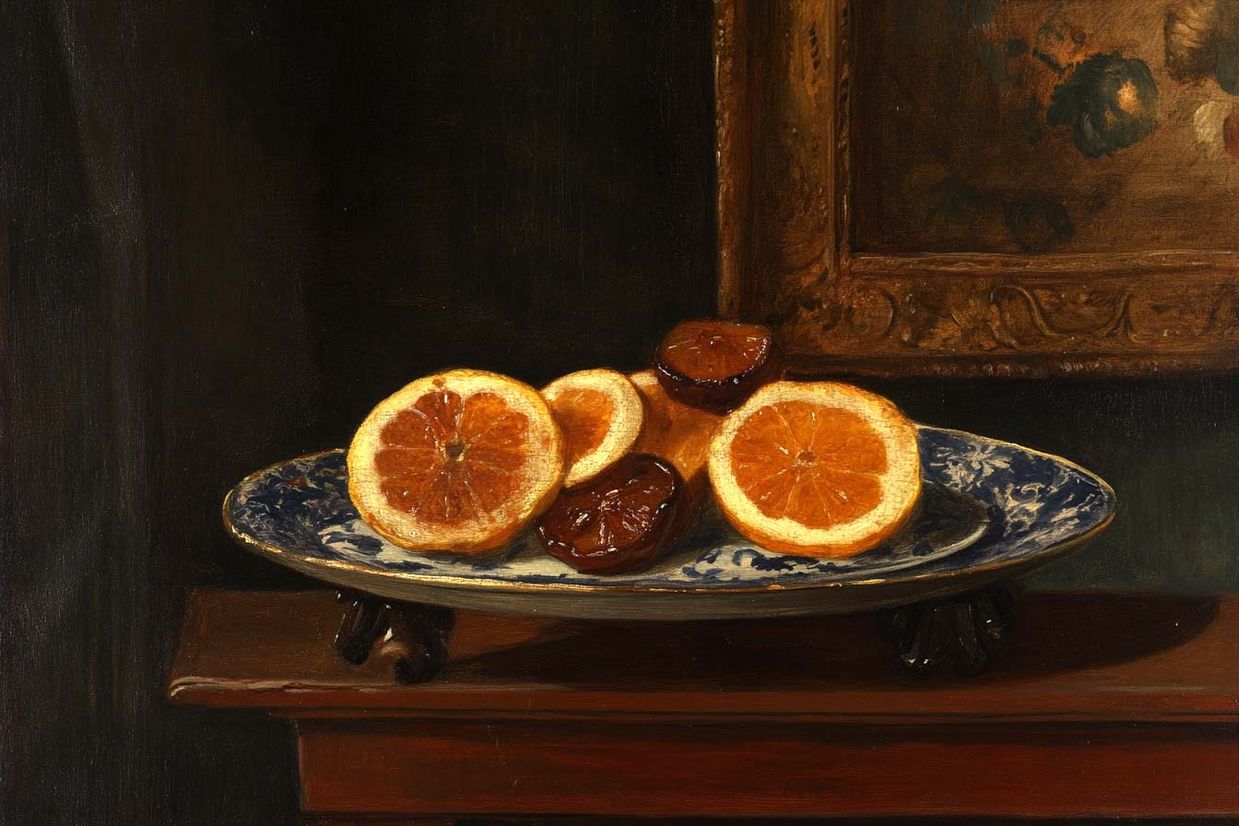
The sweets at this first table were composed of all kinds of fruit confections: fruits in syrup and glazed or candied fruits.
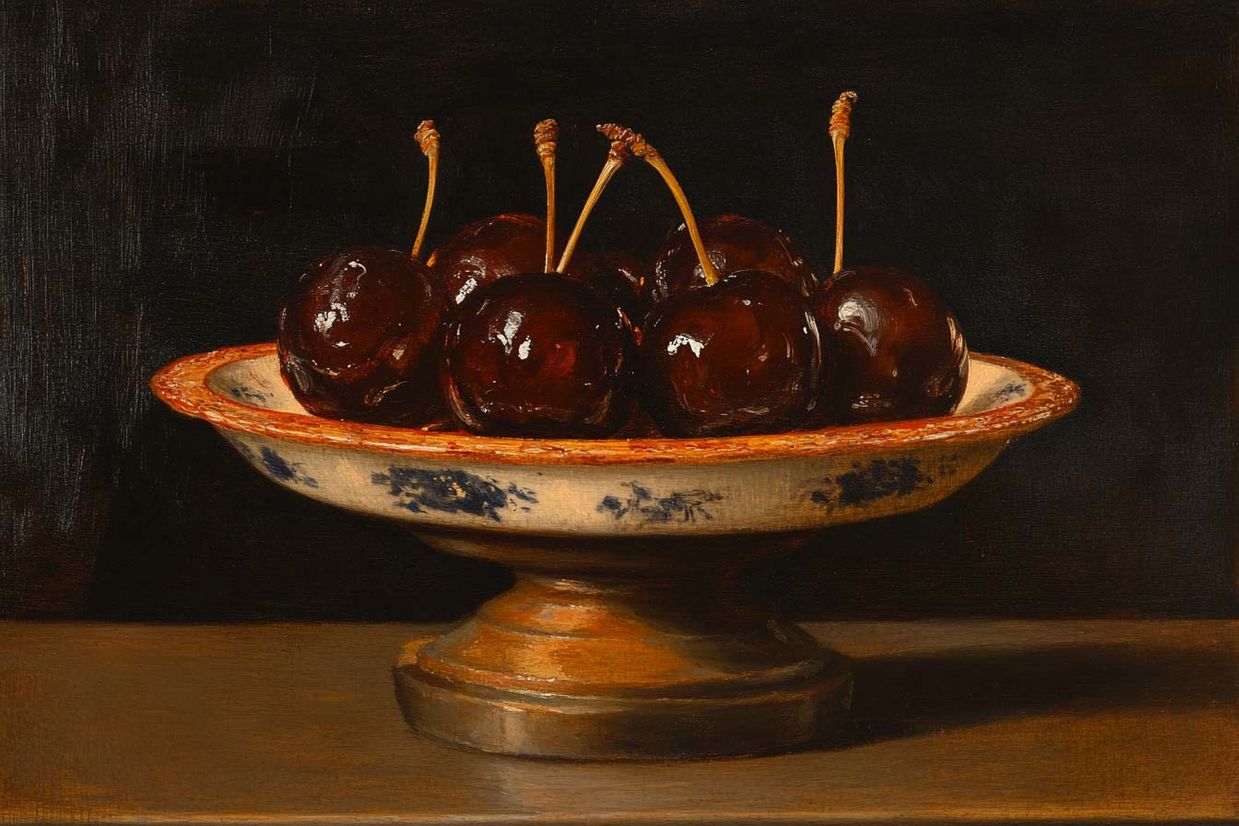
Images created with AI
They were all served on porcelain plates, as would later become the custom, as some still lifes from the 17th century, such as this one by Georg Flegel, clearly show.
Once the guests had enjoyed the fruits served on the first table, it disappeared through an opening in the ground, resembling a theater trapdoor. With sounds and lights of a second storm, the second table descended until within the reach of the guests.
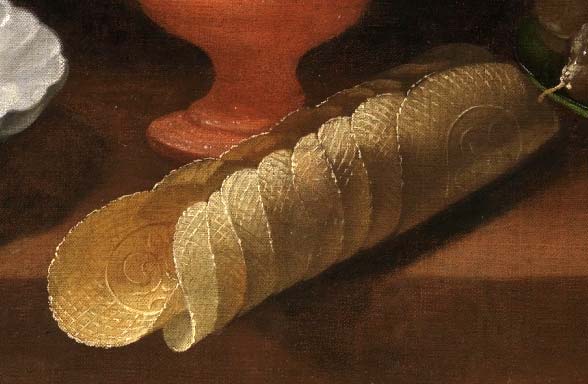
Juan Van der Hamen y León, Still Life with Sweets and Glassware, 1622. Madrid. Museo del Prado, Inv. P 001164 (Detail). © Archivo Fotográfico del Museo Nacional del Prado.
This time it was covered with dry confections made of sugar, similar to wafer cookies today, whose whiteness contrasted with the vivid colors of dyed biscuits.
The vessels for fruit preserves were no longer made of porcelain as at the first table, instead these were made of venetian glass and the flat platters for dry sweets were made of brass.
Porcelain Dish, Medici Porcelain Manufactory, ca. 1575–87. New York, Metropolitan Museum of Art, Inv. 46.114.
Dish ‘façon de Venice’, Innsbruck, mid-late 16th century. New York, Metropolitan Museum of Art, Inv. 1975.1.1180.
When the guests finished with the dry sweets, the second table disappeared beneath the floor in the same manner as the previous one. Upon hearing the roar of the storm once again, the guests, forewarned, eagerly awaited the third and final table now descending from the sky. Surprise gave way to anticipation, as the storm was the herald of new delights.
The third and final table surpassed the previous ones in beauty and complexity. In every detail, it was a most sophisticated and edible delight.
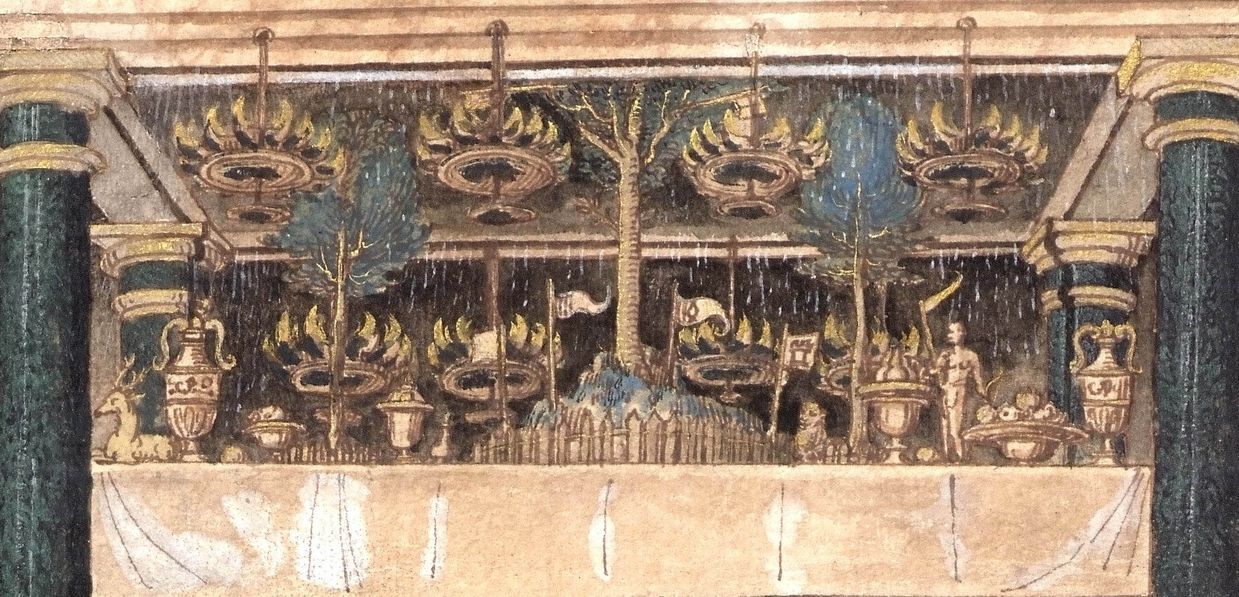
The edible sugar sculptures arranged around the perimeter of the descending platform simulated a table set for a banquet, with its saltshakers, glasses, and plates. The false tableware, in turn, surrounded a mini garden presided over by a large “rock candy” located in the center of the composition, on which three laurel trees rose, the largest of them crowning the summit of the central mountain.
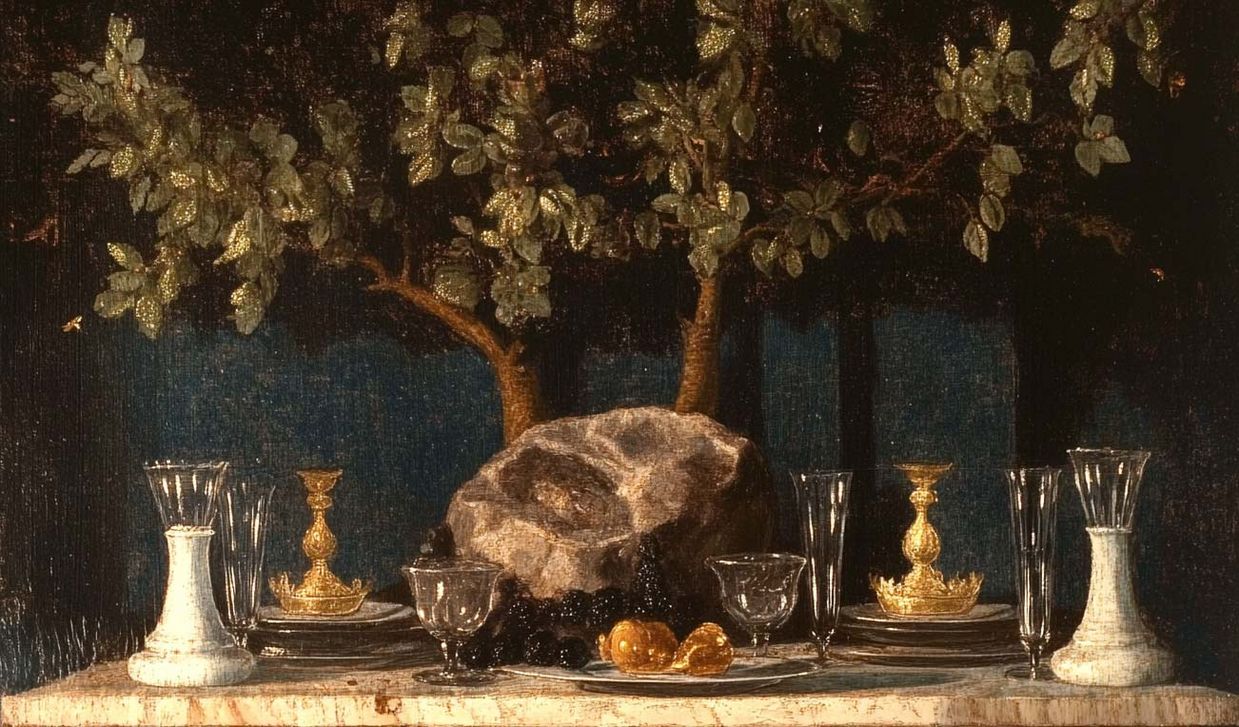
Image created with AI
Everything on the damask linen tablecloth was made, either moulded or by hand, with a paste based on white sugar and tragacanth gum diluted in rose or orange blossom water, the same flower floral scents of the perfumed rain that had just fallen on the guests. The sensations of tasting these delights contributed to reinforcing the atmosphere of an enchanted garden such as those described in chivalric tales, where, from thunder and lightn ing, erupted omens and premonitions.
Laurel trees with silver and golden leaves were symbols of fame and victory, which bore on their branches colourful silk banners with the coats of arms of all the states subjected to the Emperor's power.
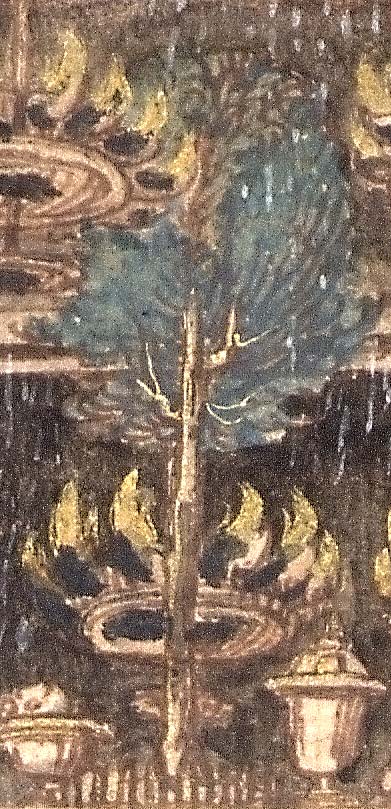

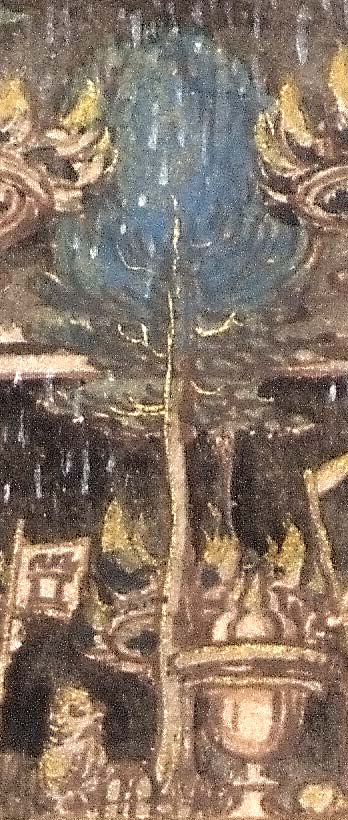
Such trees were recurrent adornments in court banquets, as seen in the Banquet of the Monarchs or in the allegories of taste by Rubens and Brueghel.
…but the guests were in for one last surprise
!
Chained to the trunk of the large central laurel tree was a live squirrel!
With this last amazing trick, the collation in the enchanted chamber came to an end. But ...
... the tastes of sweet, floral, and spicy would be the main memories of the wonderful feasts of Binche.
Clara Peeters, Still Life with Flowers, a Silver-gilt Goblet, Dried Fruit, Sweetmeats, Bread sticks, Wine and a Pewter Pitcher, 1611. Madrid, Museo del Prado, Inv. P1620. © Archivo Fotográfico del Museo Nacional del Prado.
In 1565, the marriage between the Prince of Parma, Alessandro Farnese and the Infanta Maria of Portugal took place.
Alessandro was the son of Ottavio Farnese, Duke of Parma, and Margaret of Austria, while the Infanta was the daughter of Duarte of Portugal (the great-uncle of the king of Portugal, Sebastião), and Isabel of Braganza, daughter of the deceased Dukes of Braganza (Jaime and Leonor de Guzmán).
Ottavio Farnese
2nd Duke de Parma
Margaret of Parma, daughter of the Emperor Charles V
Unknown artist, Portrait of Ottavio Farnese, 2nd Duke of Parma, 1585-91 (?). Parma, Galleria Nazionale, Inv. 1177/04.
Unknown artist, Portrait of Margaret of Parma, daughter of the Emperor Charles V, 1585-91 (?). Parma, Galleria Nazionale, Inv. 1177/03.
Alessandro Farnese
Prince of Parma
Infanta Maria of Portugal
Unknown artist, Portrait of Alessandro Farnese, Prince of Parma, 1585-91?. Parma, Galleria Nazionale, Inv. 1177/06.
Unknown artist, Portrait of Infanta D. Maria of Portugal, Princess of Parma, 1585-91?. Parma, Galleria Nazionale, Inv. 1177/05.
Upon arriving at Middelburg and the port of Arnemuiden, the entourage accompanying the Portuguese Infanta proceeded to Sas Van Gent, before continuing their journey to Brussels, making stops at significant locations such as the city of Ghent and the town of Dendermonde.
The banquets to celebrate the wedding took place at three different places: the first two at the Royal Palace of Coudenberg in Brussels, in the Grand Gallery and in the Grand Hall, on 11 November and 18 November respectively.
Pieter Brueghel the Younger and Sebastian Vrancx, The Royal Palace in Brussels, ca. 1627. Madrid, Museo del Prado, Inv. P001857 © Archivo Fotográfico del Museo Nacional del Prado.
The last banquet took place on 4 December in the Brussels City Council Room.
Circle of Frans Floris, Wedding Banquet of Maria of Portugal and Alessandro Farnese in 1565 – The Joust at the Grand Market of Brussels, 1565. Warsaw, Gabinet Rycin Biblioteki Uniwesyteckiejm Uniwersytet Warszawaskim, Inv. 10257 (Detail).
The first banquet
November 11, 1565
Brussels, Grand Gallery of the Royal Palace of Coudenberg
Circle of Frans Floris, First Wedding Banquet of Maria of Portugal and Alessandro Farnese in 1565, 1565. Warsaw, Gabinet Rycin Biblioteki Uniwesyteckiejm Uniwersytet Warszawaskim Inv. 10252.
The second banquet
November 18, 1565
Brussels, Great Hall of the Royal Palace of Coudenberg
Circle of Frans Floris, The Wedding Banquet and Main Feast held in the Grand Hall, 1565. Warsaw, Gabinet Rycin Biblioteki Uniwesyteckiejm Uniwersytet Warszawaskim, Inv.-Nr. 10253.
The third banquet
December 4, 1565
Brussels City Hall
Circle of Frans Floris, Banquet that the Gentlemen of the City of Brussels held at the City Hall, 1565. Warsaw, Gabinet Rycin Biblioteki Uniwesyteckiejm Uniwersytet Warszawaskim, Inv. 10253.
Música de Mateo Flecha "Todos los Buenos Soldados" - Jordi Savall
In addition to these magnificent banquets, we know more about the wedding between Maria of Portugal and Alessandro Farnese, because...
all the events that took place during the wedding celebrations were recreated in a watercolor album with highly detailed and precious images.
Circle of Frans Floris, Title Page of the Album of the Wedding Celebrations in Brussels of Maria of Portugal and Alessandro Farnese in 1565, 1565. Warsaw, Gabinet Rycin Biblioteki Uniwesyteckiejm Uniwersytet Warszawaskim Inv. 10247.
Immersive experience. Courtesy of Sublimotion restaurant.
The tasting of the food thus became an immersive experience, similar to what the most exclusive restaurants offer today. Visual and acoustic signals announced the changes in flavours and textures. Ambient perfumes mingled with the smells of spices and spiced wines…
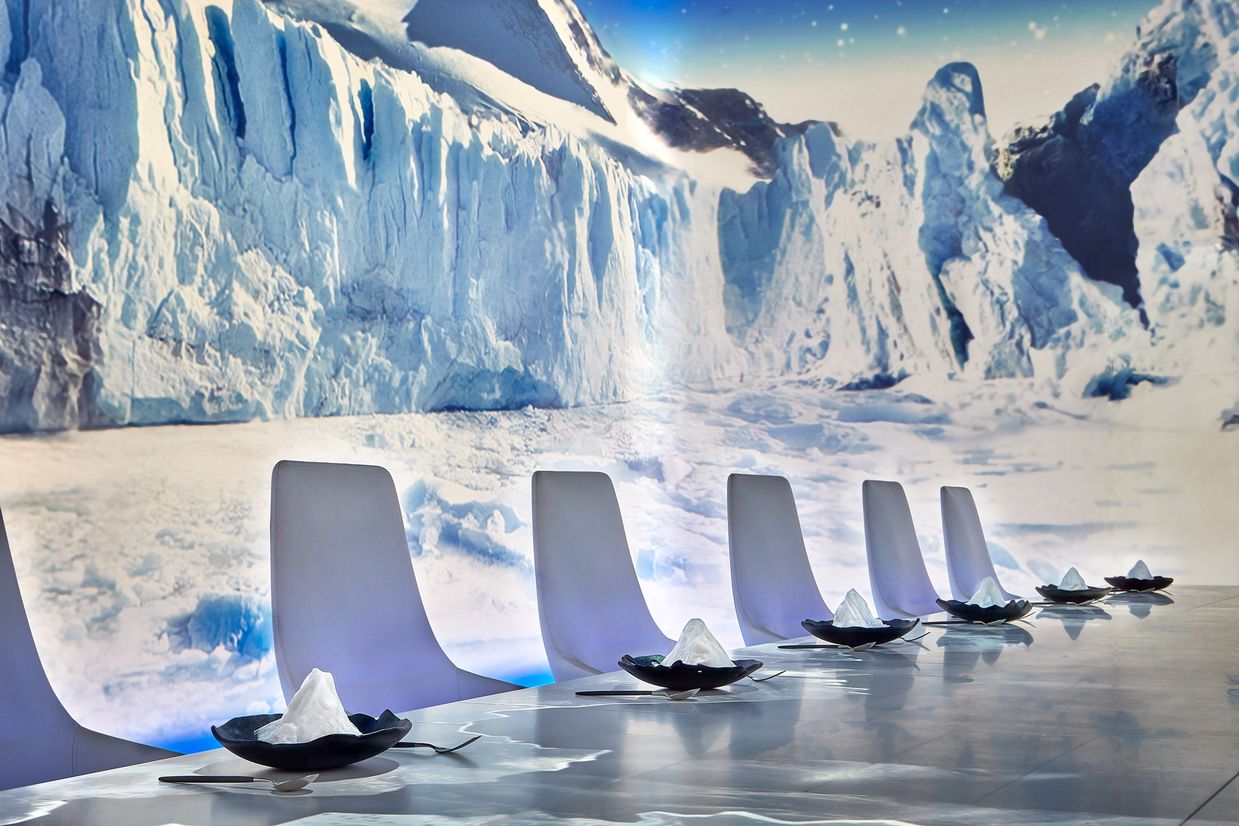
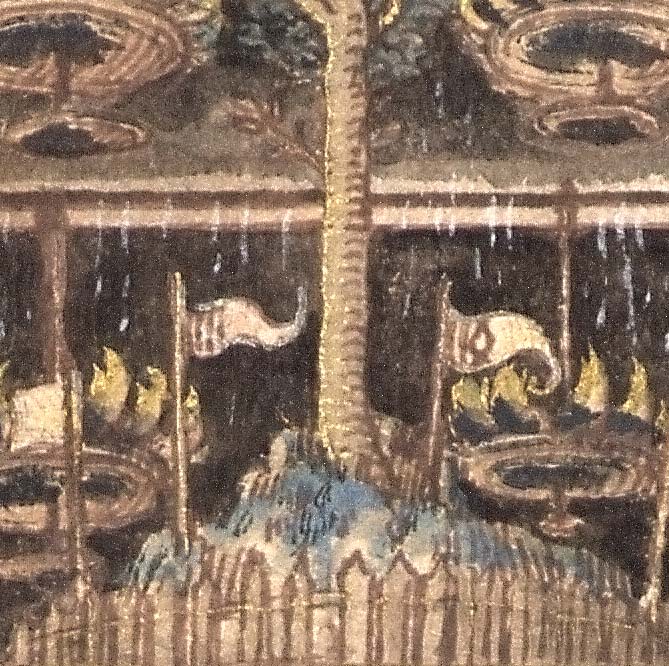
... and culinary tricks revealed their true nature as soon as they reached the mouth.
As we have seen ‘immersive experiences’ already existed in the 16th century
!
Bibliography
Primary Sources
Vicente Álvarez, Relacion del camino y buen viaje que hizo el principe de España don Phelipe nuestro señor, que passa de España en Italia, y fue por Alemania hasta Flandres donde su padre el emperador y rey don Carlos nuestro señor estava en la villa de Bruselas, [Medina del Campo, Guillermo de Millis, 1551] ed. by Paloma Cuenca, Turner, Madrid 2001.
Miguel de Baeza, Los quatro libros del arte de la confitería, ed. by Antonio Pareja, Antonio Pareja Editor, Toledo 2014.
Jerónimo Cabanillas, Relación muy verdadera de las frandes fiestas que la Serenissima Reyna doña Maria ha hecho al Principe nuestro señor en Flandes en un lugar que se dice Binche, Medina del Campo 1549.
Juan Calvete de Estrella, El felicíssimo viaje del muy alto y muy poderoso príncipe don Phelippe, ed. by Paloma Cuenca, Turner, Madrid 2001.
Livro de Cozinha da Infanta D. Maria (introduction and notes by Giacinto Manuppella), Imprensa Nacional-Casa da Moeda, Lisboa 1987.
Anonymous, Manual de mugeres en el qual se contienen muchas y diversas reçeutas muy buenas, ed. by Alicia Martínez Crespo, Ediciones de la Universidad de Salamanca, Salamanca 1995.
Giovanni Pontano, I libri dell virtù sociali, bilingual edition by Francesco Tateo, Bulzoni Editore, Roma 1999.
Sebastiano Serlio, Tutte l'opere d'architettura et prrospetiva [i.e. prospettiva] di Sebastiano Serlio Bolognese: dove si mettono in disegno tutte le maniere di edificij, e di trattano di quelle cose, che sono più necessarie a sapere gli architetti, presso gli heredi di Francesco de' Franceschi, Venice 1600.
University Library of Warsaw – Drawings Zb. Król. Wol 755.
Literature
Carmen Abad Zardoya, “Escenografía, sinestesia y cultura caballeresca en la colación de la Cámara Encantada (Binche, 1549)”, in: Carmen Gómez Urdáñez (ed.), Exhibir el lujo: de la intimidad al espectáculo. Editorial de la Universidad de Cantabria, Santander 2023.
Giuseppe Bertini, Le Nozze di Alessandro Farnese – Feste alle corti di Lisbona e Bruxelles, Skira, Milan 1997.
Giuseppe Bertini, “The Marriage of Alessandro Farnese and D. Maria of Portugal in 1565: Court life in Lisbon and Parma”, in: Cultural links between Portugal and Italy in the Renaissance, K. J. P. Lowe (ed.), Oxford University Press, 2000, 45-59.
Ana Isabel Buescu and David Felismino (ed.), A Mesa dos Reis de Portugal, Temas & Debates, Lisbon 2011.
June di Schino, “Torri, castelli, giardini, pesci e ‘animaletti scherzanti’ per la tavola del principe”, in: Vincenzo Cazzato, Sebastiano Roberto, Mario Bevilacqua (coord.), La Festa delle arti. Scritti in onore di Marcello Fagiolo per cinquant’anni di studi. Gangemi Editore, Rome 2014.
Hugo Miguel Crespo (ed.), À Mesa do Príncipe – Jantar e Cear na Corte de Lisboa (1500-1700): prata, madrepérola, cristal de rocha e porcelana, AR|PAB, Lisboa 2018.
Daniel Heartz, “Un divertissement du palais pour Carles Quint à Binche”, in: Jean Jacquot (ed.), Fêtes de la Renaissance (t.II), 2º Congreso de la Association des historiens de la Renaissance. Ed. CNRS, Paris 1960, 329–348.
Annemarie Jordan Gschwend, “Rainha d’Aquém e d’Além-Mar. Jantar e Cear à Mesa de D. Catarina de Áustria na Corte de Lisboa”, in: À Mesa do Príncipe – Jantar e Cear na Corte de Lisboa (1500-1700): prata, madrepérola, cristal de rocha e porcelana, Hugo Miguel Crespo (ed.), AR|PAB, Lisbon 2018, 11-48.
Samuel Glotz, De Marie de Hongrieaux Gilles de Binche. Une doubleréalité, historique et mythique. Introduction critique auxTriomphes de Binchecélébrés du 22 au 31 août 1549. Ed. Tradition Wallone, Brusells 1995.
Maria de Portugal – Princesa de Parma (1565-1577) e o seu tempo – as relações entre Portugal e Itália na segunda Metropolitan Museum of Artade de Quinhentos, Porto 1999.
Víctor Mínguez, Juan Chiva, Pablo González Tornel, Inmaculada Rodríguez Moya y Oskar J. Rojewsky, La fiesta renacentista. El imperio de Carlos V (1500-1558), vol. VI. Jaume I, Servei de Comunicació i Publicacions, Castellón de la Plaza 2020.
Digital Resources
Anonymous, Vergel de señores, en el cual se muestran a hacer con mucha excelencia todas las conservas, electuarios, confituras, turrones y otras cosas de azúcar y miel, s. XV, Madrid, Biblioteca Nacional de España, MSS/8565.
http://bdh-rd.bne.es/viewer.vm?id=0000060527&page=1
Anonymous, Livro de receptas de pivetes, pastilhas elvvas perfumadas y conservas, s. XVI, Madrid, Biblioteca Nacional de España, MSS/146.
http://bdh-rd.bne.es/viewer.vm?id=0000039040&page=1
Anonymous, Recetas y memorias para guisados, confituras, olores, aguas, afeites, adobos de guantes,ungüentos y medicinas para muchas enfermedades, s. XVI. Madrid, Biblioteca Nacional de España, MSS/6058.
http://bdh-rd.bne.es/viewer.vm?id=0000145867&page=1
Bartolomeo Scappi, Opera di Bartolomeo Scappi M. dell'arte del cucinare, con laquale si può ammaestrare qual si voglia cuoco, scalco, trinciante, o maestro di casa, Venice 1610 [1570].
https://books.google.pt/books?id=aCxAAAAAcAAJ&printsec=frontcover&hl=it&source=gbs_ge_summary_r&cad=0#v=onepage&q&f=false
Juan Cristóbal Calvete de Estrella, Fiestas de Bins hechas por la Serenissima Reyna María de Vngría, [1550–1552]. Madrid, Biblioteca Nacional de España, MSS/18366.
http://bdh-rd.bne.es/viewer.vm?id=0000135674&page=1
Mattia Giegher, Li Tre trattati di Messer Mattia Giegher, bavaro di Mosburg, Padua, Paolo Frambotto, 1639. Paris, Bibliothèque nationale de France.
https://gallica.bnf.fr/ark:/12148/bpt6k3101729/f5.item
Carmen Abad Zardoya, "De admirable hechura”. Esculturas de azúcar y lino en los banquetes reales, Conferencia impartida en el Museo del Prado (24-4-2021).
https://www.youtube.com/watch?v=WY3eq7WGYi4
Original recipe of some historical dishes mentioned in this exhibition
For the fake hail. Recipe “Grágea de anís labrada fina” by Miguel de Baeza (1592): “Para esta confitura tomarás tres libras de anís en grano. Y tostallo muy bien y estregallo con las dos manos, y aventar los palillos y polvo con un zedazo, y repartillo en tres veces. Y para cada vez tomarás, para comenzallo, ocho libras de azúcar blanco. Y cozello con cantidad de medio azumbre de agua y dalle su punto. Y lo yrás gastando poco a poco, y enjugando muy bien a cada caço. Y a de estar el confite bien cálido, y el açúcar también para hacer buena obra. Yen acabando la primera pressa, sacalla a enfriar y echar la segunda con otro tanto de açúcar blanco, y con cantidad de medio açumbre de agua. Y lo darás su punto y la gastaras por la misma orden, y ni más, ni menos. Y en acabando la segunda echarás la tercera, por la misma orden y manera la començaras, y en acabando de comenzar todas tres las juntaras. Y para blanqueallas tomarás veinte libras de azúcar blanco, y clarificallo as con agua de guebo…” La confitura de hinojo labrado y el culantro preparado fino se hacen del mismo modo que la grágea de anís.
From: Miguel de Baez, Los quatro libros del arte de la confitería, ed. by Antonio Pareja, Ed. Antonio Pareja Editor, Toledo 2014, pp. 37-39.
To make sugar figures in white paste. Recipe “De la pasta blanca y su orden” by Miguel de Baeza (1592): “La horden que se tiene para hacer esta pasta blanca, su fundamento, es tomar azúcar muy blanco y muy seco, y molerse en un mortero de piedra o en un almirez, y pasallo por un tamiz de seda que sea espeso, y no muy demasiado de espeso. Y ansí, tiniendo hecho este polvo, se ha de buscar goma de almendros, la más blanca o la más clara que se hallare, y ansí mesmo molerla y pasarla por un cedaço de seda, auqne no sea tan espeso como el tamiz con que se pasa el azúcar. Y tomar cantidad de quatro onzas de la misma goma, y envolver hasta una onza de azúcar molido con esto, y echarle el agua que fuere menester. Y yrle echando poquita agua, y yrlo meneando hasta que aquel agua se empape en ello. Y si esto fuere agua rosada, o de azahar, serán mejor. Y si se uviere de hacer desta pasta alcorças conviene desleír la dicha goma con agua rosada o con agua de azahar, como tengo dicho, y ansí como fueren meneándolo, que haga una correa, le echarán una clara de guebo para cada onça de goma. Y ansí como lo fueren batiendo lo yrán añadiendo del azúcar molido. Y tenga cuenta el que lo hiziere que lo vaya meneando de contino a una mano, porque no se corte y tenga mejor correa, de manera que lo vayan espesando hasta que se haga una pasta que se pueda sobar entre las manos. Y digo que para que blanquee más se ha de echar zumo de limón, o lima, y si esto no uviese vastaría echarle zumo de agraz que estuviesse claro. Y echa esta pasta desta manera la pueden sacar en un plato para yrla gastando de allí”. Las figuras se podían hacer con moldes o bien “de manos”, es decir, modelando la pasta con los dedos.
From: Miguel de Baez, Los quatro libros del arte de la confitería, ed. by Antonio Pareja, Ed. Antonio Pareja Editor, Toledo 2014, pp. 130-133.
Generic recipe for “Ypocras” from the Manual de mujeres. “Para una arroba de vino quatro onças de canela y diez libras de açúcar; rebuelto todo en un lebrillo muy bien. Y ponerlo en una manga para que se cuele, y poner en la manga un poco de almizque”.
Anonymous, Manual de mugeres en el qual se contienen muchas y diversas reçeutas muy buenas, ed. by Alicia Martínez Crespo, Ediciones de la Universidad de Salamanca, Salamanca 1995, p. 85.
Roast rabbit
“O coelho assado. Tomarão a cebola pisada muito miúda e afogá-la-ão na manteiga, e depois de afogada temperada de vinagre, e deitar-lhe-ão cravo e açafrão e pimenta e gengibre; e então tomarão o coelho espedaçado e deitá-lo-ão dentro e dar-lhe-ão uma fervura, e porão unas fatias num prato, e então deitarão o coelho em cima das fatias.”
From: Livro de Cozinha da Infanta D. Maria, Códice portugués I. E. 33. from the National Library of Naples (ed. by Giacino Manuppella), n.º XXIV.
Credits
| Title | Taste. The flavour of magnificence |
| Coordination | Carmen Abad Zardoya |
| Authors | Carmen Abad Zardoya, Pedro Flor, Daniel Ortiz Pradas, Wolfgang Laun |
| Special image permissions | Sublimotion |
| English proofreading and voice | Alexander McCargar |
